THE HEALTHY HEADWATERS ISSUE
RESTORING AND RELYING ON COLORADO'S SOURCE STREAMS
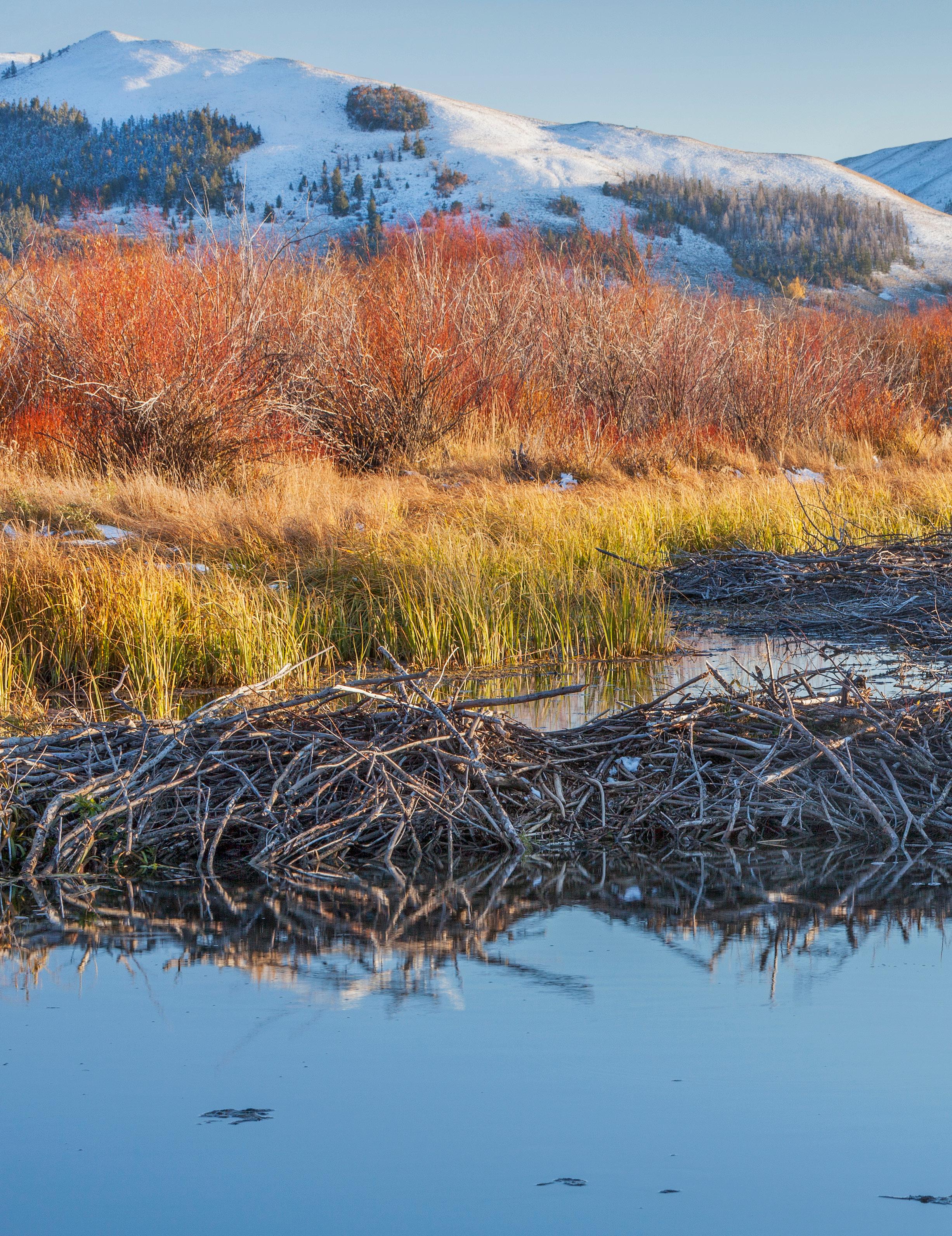
SUMMER 2023




841 E Second Avenue, Durango CO 81301 swwcd.org • 970-247-1302 • waterinfo.org Providing Water Info and Education to Communities of Southwestern Colorado Celebrating 80 Years Developing and Conserving the Waters of SW Colorado
Pulse
Colorado’s Biggest Reservoir Gets a Reprieve
After a series of bleak years, Blue Mesa Reservoir, one of four big federal reservoirs on the Upper Colorado River System, is refilling this summer. While those who rely on the reservoir and the river are relieved, officials warn that a drier future still awaits.
Climate Change Hits Home in Durango
A new study shows how much climate change and drought are impacting Durango’s water supply. Now the city is fast-tracking plans to tap Lake Nighthorse for storage and to boost its water-saving efforts.
THE NATURAL INFRASTRUCTURE AND HEALTHY HEADWATERS ISSUE In the face of climate change and population growth, wildfire, drought and flooding, many in Colorado are looking to invest in natural infrastructure, or the beneficial functions healthy natural systems provide, to boost resilience for both communities and ecosystems. Restoration of the state’s headwater systems—where rivers and streams begin flowing—is gaining increased attention. It’s an evolving science and isn’t without challenges, however, and much remains unknown about how changes to these systems will affect downstream water users.
Where Messy is Best
As Colorado’s source streams are rapidly changing, researchers, restoration practitioners, and downstream communities alike are looking to the past and learning from more pristine headwater systems to regain resilience.
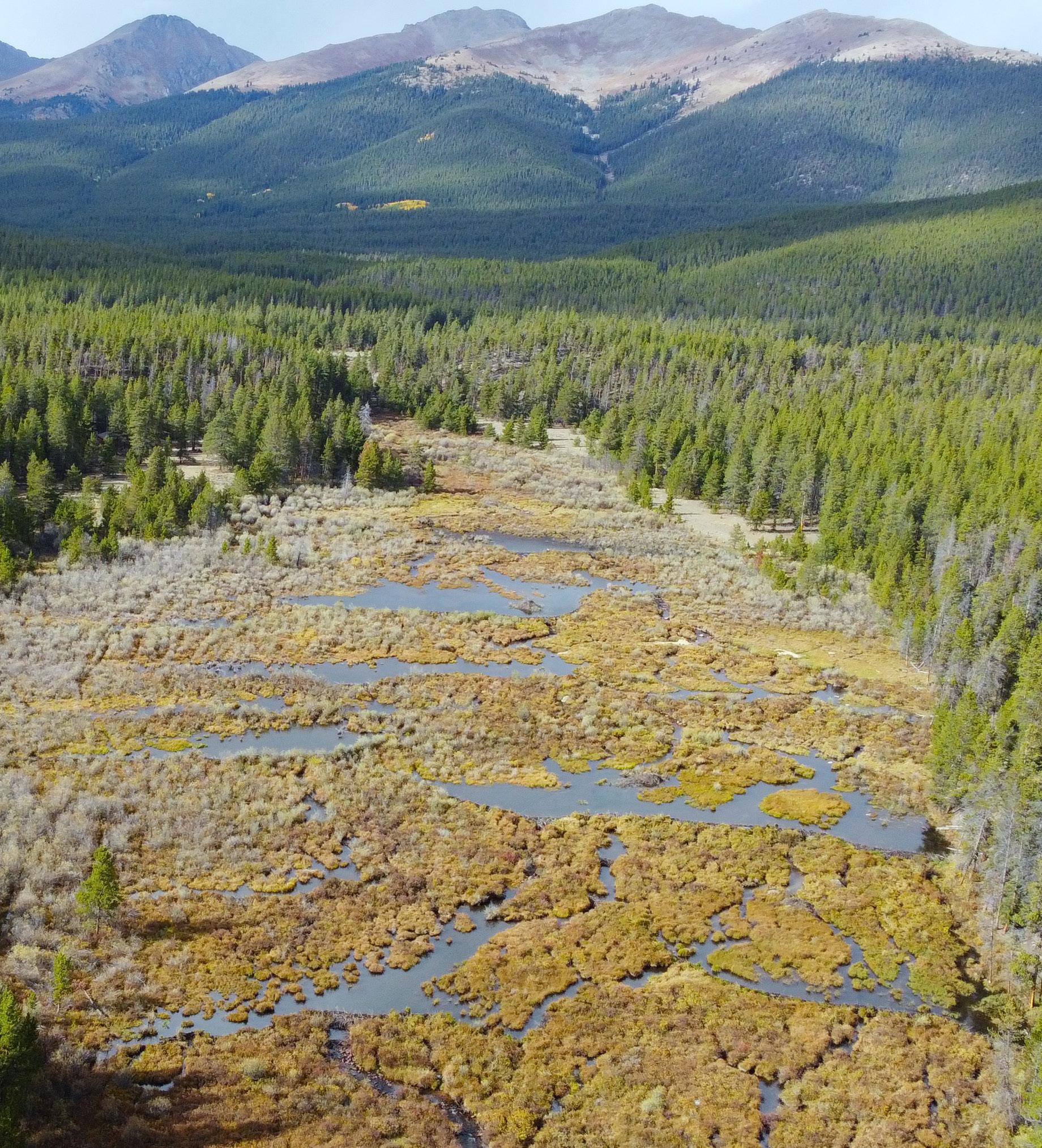 By Kelly Bastone
By Kelly Bastone
Busy as a Beaver
As climate change brings aridification to the West, the reclamation projects that shaped water use across Colorado could be entering a new era, with a future that looks nothing like the past
By Moe Clark
HEADWATERS SUMMER 2023 • 3
| Summer
Above: Red Mountain Creek at the headwaters of the Gunnison River on Colorado’s Western Slope is considered a “stage-zero” system with a healthy beaver stream.
Contents
2023
On the cover: A beaver dam slows and
water
DIRECTOR’S NOTE Inside 6 4 FROM THE EDITOR WHAT WE’RE DOING WEco's upcoming events, reporting and more. 5 AROUND THE STATE Water news from across Colorado. 10 MEMBER’S CORNER Celebrate the impact of WEco’s members. 31
Photo
by Mark Beardsley, courtesy of EcoMetrics
pools
on the North Platte River in Colorado. Photo by Marekphotodesign.com/Adobe Stock
8 9
2o
11
DIRECTOR’S NOTE
For over a decade Water Education Colorado has collaborated to host the annual Sustaining Colorado Watersheds conference, coming this year on Oct. 3–5. The conference features a wide variety of subject matter, from science to policy and planning, at the intersection of human civilization and the natural environment.
Much of it revolves around the preservation and restoration of the natural functions that intact watersheds and riverine ecosystems provide. WEco, along with our conference partners, the Colorado Watershed Assembly and the Colorado Riparian Association (CRA), each bring different perspectives and expertise. For CRA, whose work promotes healthy riparian areas and wetlands, presentations focused on practices like process-based restoration or beaver-dam analogues, where structures akin to beaver dams are purposefully constructed to replicate their function, have been rising in prominence thanks to their leadership.
Humanity has always mimicked nature to some degree in a constant process of innovation and adaptation. And currently we see an accelerating trend and mindset shift toward “nature-based” solutions and investment in natural infrastructure. After years of being inspired by this type of work at the conference, it was particularly rewarding to get to feature it in this issue of our magazine.
You’ll learn more about why beavers are important, the ways in which seemingly “messy” ecosystems bring an inherent resilience, and how communities and organizations are investing to restore these natural states, for both anthropogenic and ecological reasons, within these pages—and at the conference this fall.
In mid-June, my 13-year-old son saw a juvenile beaver wandering through a marshy area along the local creek that bisects our urban Denver neighborhood. Just weeks earlier, while camping at State Forest State Park near Walden, Colorado, he and I had been exploring North Michigan Reservoir on paddleboards in the still of a morning when we heard the echoing telltale slap of a beaver tail on water. We were lucky to glimpse him before he dove to some unseen shelter. Beavers, of course, though largely extirpated during the fur trade of the 1800s, were once prolific across Colorado and much of North America, and our ecosystems adapted alongside—and as a result of— these busy habitat engineers. Witnessing these animals in both environments felt like an optimistic sign that we can co-exist.
As you return from your summer adventures and exploits, I invite you to attend our fall events, both the conference, in Avon, as well as our annual President’s Reception, on Sept. 6 in Denver. There we will raise money for our educational mission, as well as celebrate that never-ending process of learning and adapting by honoring two individuals whose admirable work is helping shape the future of water in Colorado and more broadly across the West. I hope to see you there.
Until then, we’ll keep after the work of informing Coloradans about our most precious natural resource. And maybe spot another beaver or two.
STAFF

Jayla Poppleton Executive Director

Sabrina White Programs Director
John Carpenter Operations Manager
Geoff Harlan
Membership and Development Manager
Suzy Hiskey Administrative Assistant
Cailyn Andrews Education and Outreach Coordinator
Jerd Smith Fresh Water News Editor
Caitlin Coleman Publications and Digital Resources Managing Editor
Charles Chamberlin Headwaters Graphic Designer
BOARD OF TRUSTEES
Lisa Darling President
Dulcinea Hanuschak
Vice President
Brian Werner Secretary
Alan Matlosz Treasurer
Cary Baird
Perry Cabot
Nick Colglazier
David Graf
Eric Hecox
Matt Heimerich
Julie Kallenberger
David LaFrance
Dan Luecke
Karen McCormick
Leann Noga
Peter Ortego
Dylan Roberts
Kelly Romero-Heaney
Ana Ruiz
Elizabeth Schoder
Don Shawcroft
Chris Treese
Katie Weeman
THE MISSION of Water Education Colorado is to ensure Coloradans are informed on water issues and equipped to make decisions that guide our state to a sustainable water future. WEco is a non-advocacy organization committed to providing educational opportunities that consider diverse perspectives and facilitate dialogue in order to advance the conversation about water.
HEADWATERS magazine is published three times each year by Water Education Colorado. Its goals are to raise awareness of current water issues, and to provide opportunities for engagement and further learning.
THANK YOU to all who assisted in the development of this issue. Headwaters’ reputation for balance and accuracy in reporting is achieved through rigorous consultation with experts and an extensive peer review process, helping to make it Colorado’s leading publication on water.
© Copyright 2023 by the Colorado Foundation for Water Education DBA Water Education Colorado. ISSN: 1546-0584
CSU Spur, Hydro/The Shop, 4777 National Western Drive, Denver, CO 80216 (303) 377-4433
4 • WATER EDUCATION COLORADO
What we’re doing
Annual River Basin Tour a Success
In June we toured the Yampa/White/Green River Basin with a bus full of legislators, water professionals, and interested community members. Tour stops included a dam and hydropower plant, a wastewater treatment plant, a sustainable research ranch, the headwaters of the Yampa River, a coal-fired power plant, and more.

Fresh Water News at Five
On July 1 Fresh Water News passed the five-year mark. We’ve been publishing original content since 2018, sending our weekly news report directly to subscribers and sharing articles for reproduction with media outlets statewide.
Over our five-year history, we’ve become members of the Colorado Press Association and we created, in partnership with the Colorado News Collaborative, a training program for journalists interested in reporting more effectively on water issues. We launched Fresh Water News TV, and worked with PBS’ documentary series This American Land, to produce national news clips and documentary segments on Colorado water.
Looking ahead, we are committed to continuing to provide independent, nonpartisan reporting on water issues in Colorado and the West that helps voters, taxpayers and public officials understand water in ways they never have before.
If you aren’t yet a subscriber, sign up now at wateredco.org/fresh-water-news.
Welcome to the Team!
Water Education Colorado welcomed two new team members in May: John Carpenter, Operations Manager, and Geoff Harlan, Membership and Development Manager.
John specializes in overseeing finance and operations for nonprofits, having previously worked for Omni Institute, Alliance for Sustainable Colorado, and Rebuilding Together Metro Denver.
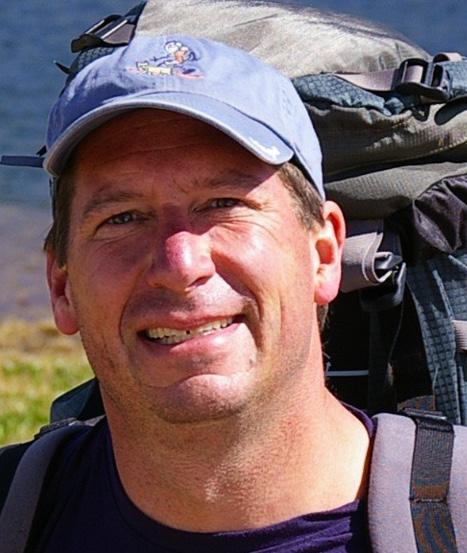

Prior to joining our team, Geoff managed capital campaigns, an annual fund, and major gifts for a private school. He has also worked in a variety of educational administrative roles and spent the first 19 years of his career as a collegiate football coach.
Help us welcome John and Geoff!
De Donde Viene Su Agua
WEco’s first Spanish-language reference primer is now available and the second one will be out this summer! We’ve translated our Guide to Where Your Water Comes From into Spanish and are working on our Guide to Colorado Water Law.
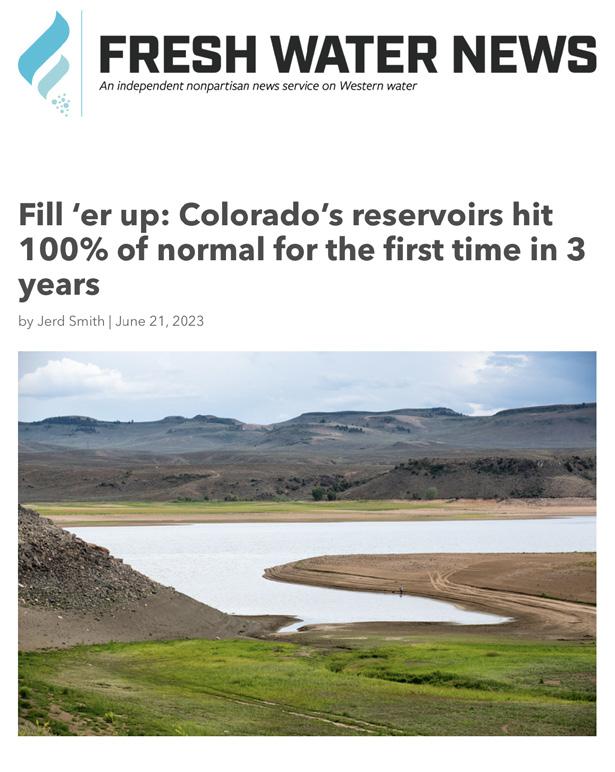
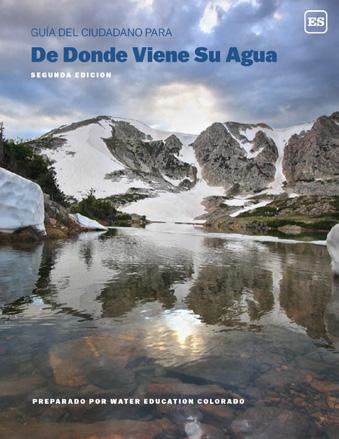
Know someone who needs a copy or an organization for us to partner with? Let us know and order your copy from our shop at watereducationcolorado.org.
Thank you to the following sponsors for supporting the Where Your Water Comes From translation: Colorado Water Conservation Board, Rio Grande Water Conservation District, Colorado Water Resources and Power Development Authority, Colorado Springs Utilities, Colorado River District, Pueblo Water, Denver Water, Southwestern Water Conservation District, and Aurora Water.
HEADWATERS SUMMER 2023 • 5
WEco's newest team members John Carpenter (left) and Geoff Harlan (right).
What we’re doing
A Conversation with SENATOR DYLAN ROBERTS
FROM THE EDITOR

River restoration may seem like a technical science, and in many ways it is. But in this issue of Headwaters magazine, we see how deeply steeped we are in investigating, researching, and better understanding the art of stream and riparian restoration and the impacts of natural infrastructure on our built downstream communities. We’re still actively putting the scientific method to work and answering questions to make restoration better and easier.
That’s because researchers and practitioners are grappling with the challenge of drawing definitive conclusions around the impacts of restoration. Projects tout myriad benefits such as filtering out pollutants, capturing sediment, storing more water on the landscape, and moderating soil moisture. Read more about the benefits and methodology of restoring and preserving Colorado’s headwater systems in “Where Messy is Best” (page 11).
But, there’s still uncertainty around certain impacts to downstream water users.
In “Busy as a Beaver” (page 20), we focus on the benefits and challenges with low-tech process-based restoration projects (LTPBR), which often mimic beaver to restore stream systems’ natural processes. If you hold more water high on the landscape by mimicking the structures that a beaver would create, are you affecting downstream water rights and the timing when that water will be available to those who have come to depend on it?
The research done so far hasn’t conclusively answered that question because the scale and complexity of required study is enormous, says Julie Ash, a restoration practitioner with Stillwater Sciences.

“We do not have certainty right now,” Ash says. “Neither side can make definitive statements.”
That question came to light this spring with Colorado’s SB 23–270 which was signed into law in June. The final law clarifies that minor stream alterations are presumed not to impact water rights users, so don’t need to go through a water court process.
Senator Dylan Roberts

We spoke with Senator Roberts, a member of the WEco Board of Trustees and chair of the Colorado Senate Agriculture and Natural Resources Committee, about Senate Bill 270, signed into law in early June. Sen. Roberts sponsored this bill on Projects to Restore Natural Stream Systems and continues to work with constituents and the committee on next steps related to restoration. Read more on the blog at watereducationcolorado.org.
But bigger projects still need to go through water court and permitting processes, which can stand in the way of getting that restoration work done.
It’s possible that another bill could address those larger projects in the future.
“We need to figure out the size of projects, or the scope of projects that would be acceptable to move forward outside of the water court process,” says Senator Dylan Roberts, one of the sponsors of this year’s bill. (Sen. Roberts also serves on the WEco Board of Trustees.) Read the full Q&A with Sen. Roberts on our blog at wateredco.org. And while it’s hard to say how soon follow-up legislation could be introduced, it remains a priority for lawmakers.
“Ideas in water take a lot of time to discuss and we don’t want to rush into anything and have things result in unintended consequences,” says Sen. Roberts. “I’ve heard that everyone thinks stream restoration projects are a good thing,” he says. “Just keeping it at the top of everybody’s radar will help a lot to make folks more comfortable.”
I look forward to watching the evolving science and policy of restoration and seeing where we go next!
6 • WATER EDUCATION COLORADO
“I’ve heard of and personally seen many great stream restoration projects across my district and across the state and have been able to see the value of them and the way they preserve our environment and protect our watersheds. That is one of the reasons why I was very enthusiastic to sponsor the stream restoration legislation last session.”
—Editor—



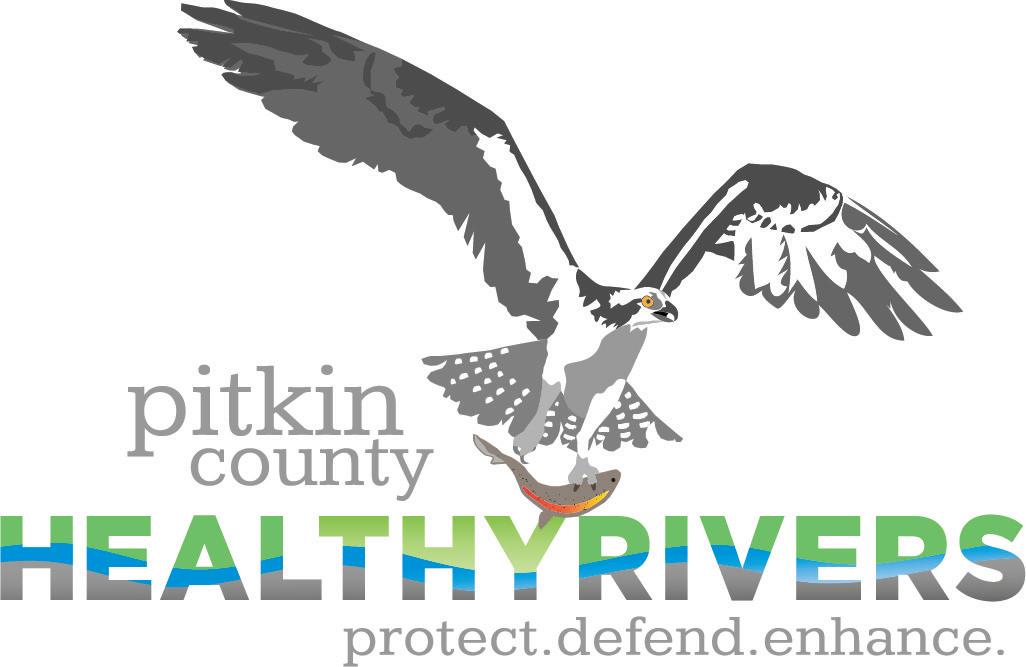
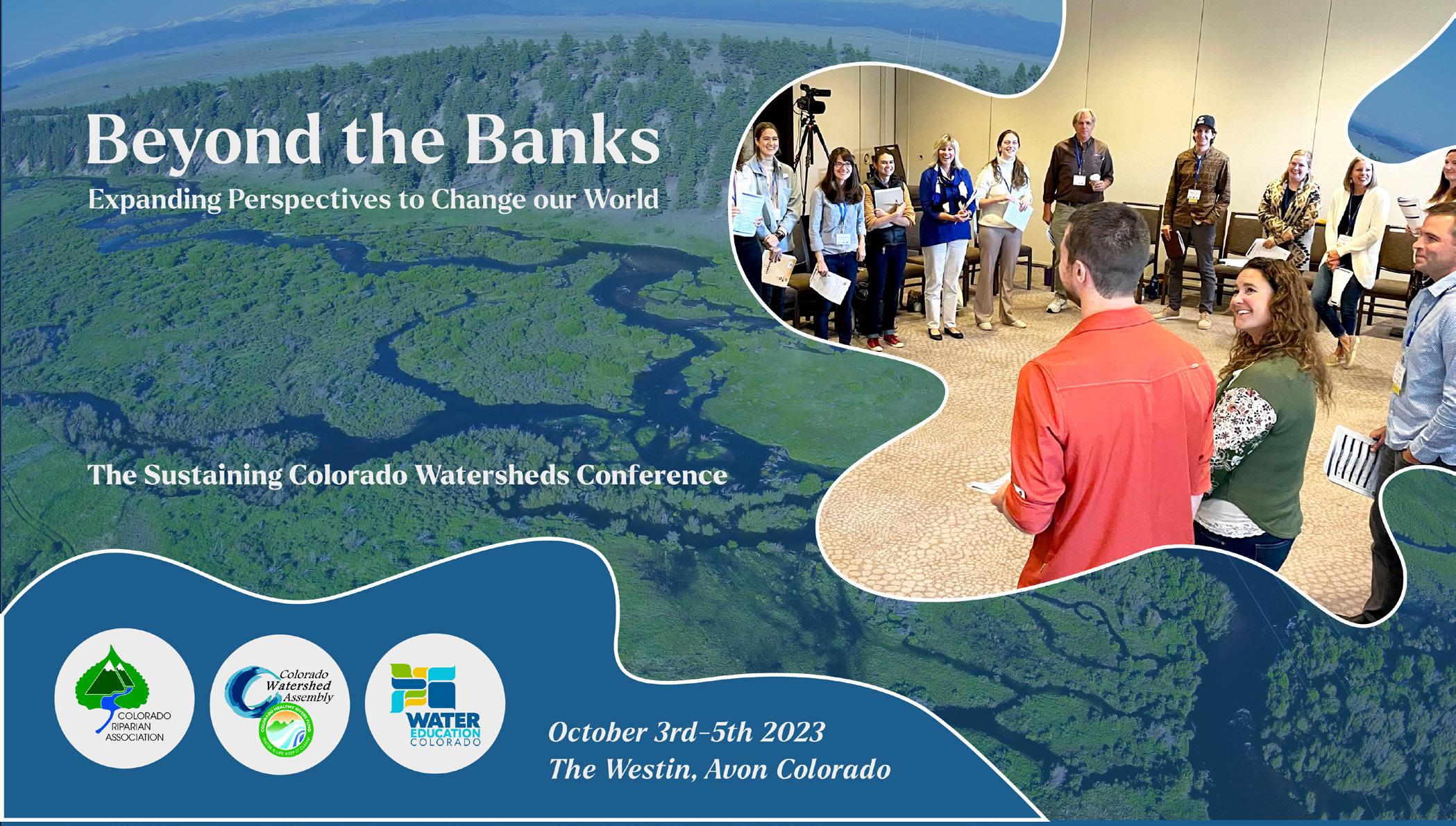

HEADWATERS SUMMER 2023 • 7 Delivering best-fit solutions and responsive services for all your water resources planning, water rights and water quality needs in Western Colorado www.sgm-inc.com | 970.945.1004 GLENWOOD SPRINGS • GUNNISON • DURANGO GRAND JUNCTION • ASPEN • SALIDA • MEEKER SAVE THE DATE! SUPPORT WECO AND FRESH WATER NEWS ON COLORADO GIVES DAY, DEC. 5.
Pulse Colorado’s Biggest Reservoir Gets a Reprieve
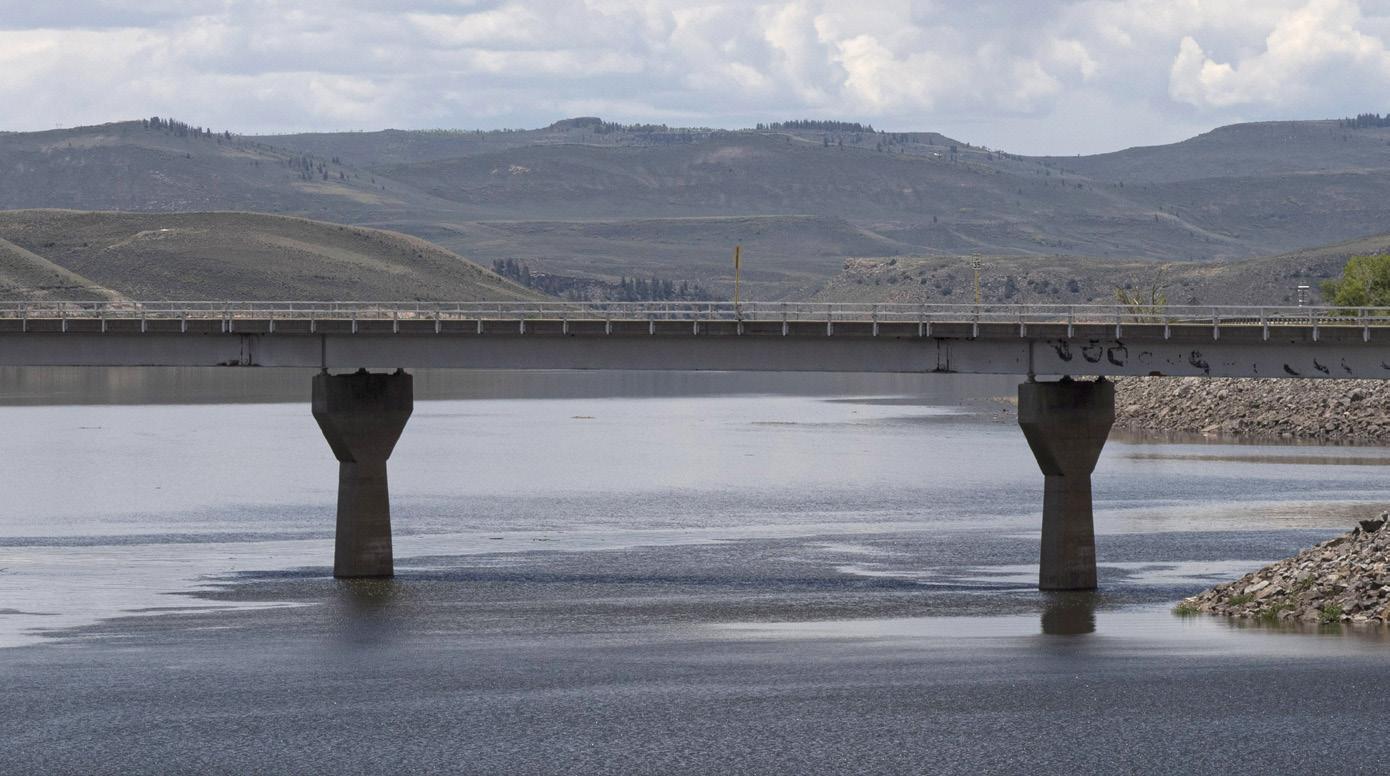 BY JERD SMITH
BY JERD SMITH
Southwestern Colorado’s Blue Mesa Reservoir, drained by years of drought and a major release of water designed to aid a plummeting Lake Powell, is experiencing a rebirth this summer and is expected to fully fill by the end of the recreation season.
“The water has been shooting up,” says Eric Loken, who manages the two marinas on the reservoir.
Blue Mesa is one of four federal reservoirs in the Upper Colorado River Basin designed to hold water to help the Upper Basin states—Colorado, New Mexico, Utah and Wyoming—meet legal obligations to send water downstream to Arizona, California and Nevada. The other Upper Basin reservoirs include Utah’s Flaming Gorge, New Mexico’s Navajo, and Utah and Arizona’s Lake Powell.
In 2021, already partially drained by years of drought and thin snowpacks, millions of gallons of water were sent from Blue Mesa downstream to Lake Powell in an effort to bolster that reservoir and keep hydropower-generating turbines operating. Even more water was released upstream that year, from Flaming Gorge.

But this year, thanks to abundant snows and a cool, rainy spring across the region, Blue Mesa and Flaming Gorge are in recovery mode, according to Alex Pivarnik, a U.S. Bureau of Reclamation hydrologist.
“Flaming Gorge is on the up. Blue Mesa is on the up. Powell is going to be increasing as well,” Pivarnik says.
Two years ago the picture was much different. Marina operators were scrambling to move docks and gasoline as reservoir levels plummeted.
Blue Mesa is Colorado’s largest reservoir, holding more than 940,000 acre-feet of water when it is full. An acre-foot of water equals nearly 326,000 gallons and is enough to serve two to four urban households for one year.
Last year, with little recovery in sight, Loken was forced to close the Elk Creek Marina, the largest on Blue Mesa. He, and the thousands of boaters, campers and anglers who visit the giant watering hole, worried that the future was so bleak that the reservoir might not recover.
“There was some concern that it would never refill,” Loken says. “There was concern we might have to send everything we had downstream [to Powell].
“But this year we are way up. It’s a lake again. It’s quite nice,” he says.
And for this year, at least, as the water levels rise, federal officials say there will be no need for additional emergency releases under a special drought plan approved in 2019, giving everyone some room to breathe and enjoy the giant pool.
“There is no plan to do additional drought response [releases] in 2023,” Pivarnik says. “But we don’t want people to sit there and think one good year of runoff and snowpack get you out of 20 years of drought. We still have to manage for a drier future.” H
8 • WATER EDUCATION COLORADO
William Woody
Blue Mesa Reservoir began refilling in 2023. This view shows the reservoir and the Colorado Hwy 149 bridge, photographed from a location off U.S. Hwy 50, on Sept. 5, 2021, and June 6, 2023.
Climate Change Hits Home in Durango
BY JERD SMITH
Climate change has come home to Durango, with a new study indicating that the city has gotten so dry that it can no longer depend solely on direct flow from the Florida and Animas rivers for a reliable water supply.
Like other small towns in Colorado, Durango has very little water storage, enough to last for less than 10 days. It has always relied on its ability to pull water directly from the Florida River, using the Animas River as backup. But that is no longer possible, prompting the city to fast-track a major regional pipeline project and to double down on conservation.
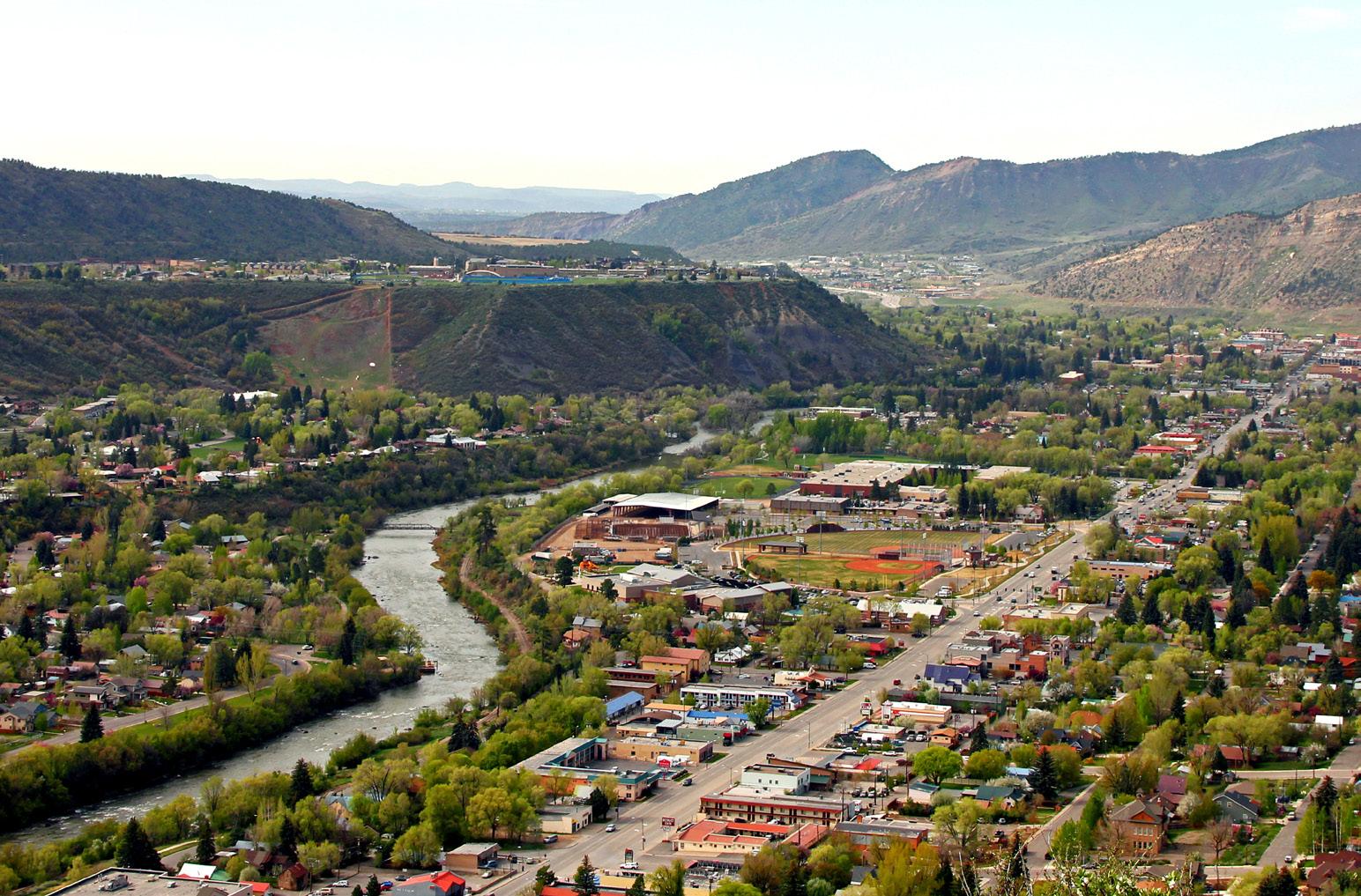
A new study of stream gage data conducted for Durango by the Mountain Studies Institute (MSI) shows that average annual precipitation in one of the town’s major watersheds
has declined as much as 20% annually since the late 1980s and runoff, the water that eventually makes it to the stream, has dropped even more, as much as 35% in the Florida River watershed. The same trend, though to a lesser extent, is also showing up in the Animas River watershed.
“It’s eye opening,” says Jarrod Biggs, Durango’s assistant finance director who has overseen much of the city’s recent water planning efforts. “It is a significant difference from where we were a decade or two ago.”
Jake Kurzweil, a hydrologist and associate director of water programs at MSI who conducted the study, said the declines illustrate how watersheds have begun to dry out as the climate warms.
Peter Goble, a climatologist at the Colorado Climate Center
housed at Colorado State University, cautioned that the region’s 1,200-plus-year megadrought likely exaggerates the level of declines seen in the MSI data. He also says that long-term climate warming forecasts don’t show dramatic drying trends in the next 30 to 40 years.
“[Kurzweil] is comparing a time when we scarcely had any droughts to a period that has been quite dry. Precipitation can vary widely and our climate models don’t show this clear drying signal … if anything climate models show that precipitation may increase just a little bit,” Goble says.
Kurzweil acknowledges that the megadrought has exacerbated the drying seen in Durango’s river systems, but he says he thinks the trend will likely continue, in part because though Northern Colorado
could see more precipitation as its climate warms, Southwestern Colorado could be drier.
Durango’s Biggs says the city planned to build a pipeline from Lake Nighthorse, a federal reservoir built in the early 2000s, at some point in the future to access more storage. But such a project, likely to cost tens of millions of dollars, was a long-term goal, not an immediate need.
The new analysis has prompted Durango to fast-track the project.
“Presenting the data to our decision makers compelled them to move ahead with something we had been thinking about for quite some time,” Biggs says. “Now, we want to activate this water in the near term. We don’t want to be in a situation where in five years we need it and we still haven’t built the pipeline.”
Durango is working with regional partners including the Southern Ute Indian Tribe, in Ignacio, and the Ute Mountain Ute Tribe, in Towaoc, as well as the U.S. Bureau of Reclamation and others to see if the pipeline can be built in the next five years and provide benefits throughout the region.
“We are going to have to do with less water,” Biggs says. “So in the same breath when we talk about a pipeline we also have to talk about conservation.” H
This story originally appeared in Fresh Water News, an initiative of Water Education Colorado. Read Fresh Water News online at watereducationcolorado.org.
HEADWATERS SUMMER 2023 • 9
Jerd Smith is editor of Fresh Water News.
Adobe Stock
The Animas River winds through downtown Durango, Colorado.
Around the state |
ARKANSAS RIVER BASIN
BY CAITLIN COLEMAN
The Colorado Supreme Court, in early June, ruled that a case focused on fishing access in the Arkansas River had no legal standing. The lawsuit, The State of Colorado v. Roger Hill, was initiated more than a decade ago after Hill waded into the Arkansas River to fish and was shooed away by a private landowner. Hill’s lawsuit argued that the riverbed was held in trust by the state and open to wading. The case could have had far-reaching consequences for public access to wade and fish certain streams in the state and could even have upset years of water law and the way water rights are administered. But the high court found that Hill did not have a legal basis for his case.
GUNNISON RIVER BASIN
The City of Gunnison has started to design and is gathering input on where to locate a new $20-$30 million water treatment plant, according to the Gunnison Times. Currently, rather than a water treatment plant, the city uses a well system to supply drinking water to its residents, where nine wells pump chlorinated groundwater directly into water lines that pipe it to homes and businesses. The new treatment system, which is expected to take 10-15 years to complete, will reduce the risk of contamination.
YAMPA RIVER BASIN
High levels of lead, above state and federal action levels, are showing up in some homes around Steamboat Springs, reports the Steamboat Pilot & Today. In recent tests completed by the Mount Werner Water and Sanitation District, nine of 60 homes sampled tested too high for lead. The water district is working on corrosion control improvements to resolve the lead issue and developing a funding strategy to implement those upgrades. Improvements should be installed by Thanksgiving 2024.
COLORADO RIVER BASIN
The Vail Daily reports that by mid-June, Vail area streamflows appeared to have peaked for the season. This year’s peak on the Eagle River above Gore Creek came both earlier on the calendar and with lower flows than average, while on Gore Creek, peak flows came slightly later and just 1% lower than average. As flows peaked, Eagle County’s emergency manager issued warnings about the risk of flooding, particularly for those who live within a floodplain.
NORTH PLATTE RIVER BASIN
Late this spring, the U.S. Bureau of Land Management announced that it will invest $160 million nationwide in “restoration landscapes” with $5 million going to North Park near Walden, reports Colorado Public Radio News. North Park is home to the largest wetland complexes in the state. Funds invested there will help ensure that wetlands stay wet and that creeks and rivers are connected to the landscape, creating riparian wetlands. Not only will this work protect North Park’s wetlands, but it will also help maintain habitat for the region’s sage grouse population.
RIO GRANDE BASIN
County governments across the San Luis Valley have been banding together, pursuing “1041” agreements to protect the basin’s water from export schemes, reports the Alamosa News. In the already water-stressed Rio Grande Basin, last year developers proposed to drill into the aquifer to export water from the basin to the Front Range. Other export schemes have been proposed and opposed over the years. Under state law, counties can adopt what are known as “1041 regulations,” allowing them to regulate certain types of development, giving them more veto power should such an export scheme be proposed again. While individual counties can adopt their
own regulations, the San Luis Valley Council of Governments drafted an Intergovernmental Agreement which calls for all six counties in the valley to agree on it. This would provide a new valley-wide layer of protection for groundwater, but, as of this spring, the IGA was tabled in some counties.
SAN JUAN/DOLORES RIVER BASIN
This spring, the Dolores River Basin in southwestern Colorado laid claim to the highest snowpack levels in the state, at 254% of average in early May, reports Fresh Water News. The Dolores rarely flows enough to allow for boating, so this year’s season is particularly exciting for thousands of boaters.
As the Colorado Sun reports, a new film “The River of Sorrow” was recently released, showing footage from last year of the Dolores running at just a trickle. Coupled with this year’s high flows, the film is building support for protections on the Dolores River, including proposed federal legislation to establish a national conservation area, and a new proposal to establish a national monument on the Dolores.
SOUTH PLATTE RIVER BASIN
Big federal dollars are coming to Denver to restore the South Platte River, reports Denverite. In April, the Denver City Council approved a partnership between the City of Denver and the U.S. Army Corps of Engineers for restoration work along a 6.5mile stretch of the South Platte from 6th to 58th Avenue. The $550 million project will receive an initial $350 million in federal funding, with the rest of project costs to be covered by city sources in the future. The project is expected to take 10 years to complete and should make strides in reducing flood risk, ensuring healthy ecosystems along the river, fulfilling some of the city’s recreational vision, addressing environmental justice, and more. H
10 • WATER EDUCATION COLORADO
Where Messy is Best
Most of Colorado’s source streams are changing rapidly and look nothing like they did a couple hundred years ago. With climate change impacting headwater areas, we’re learning to appreciate what was lost—and what can be regained.
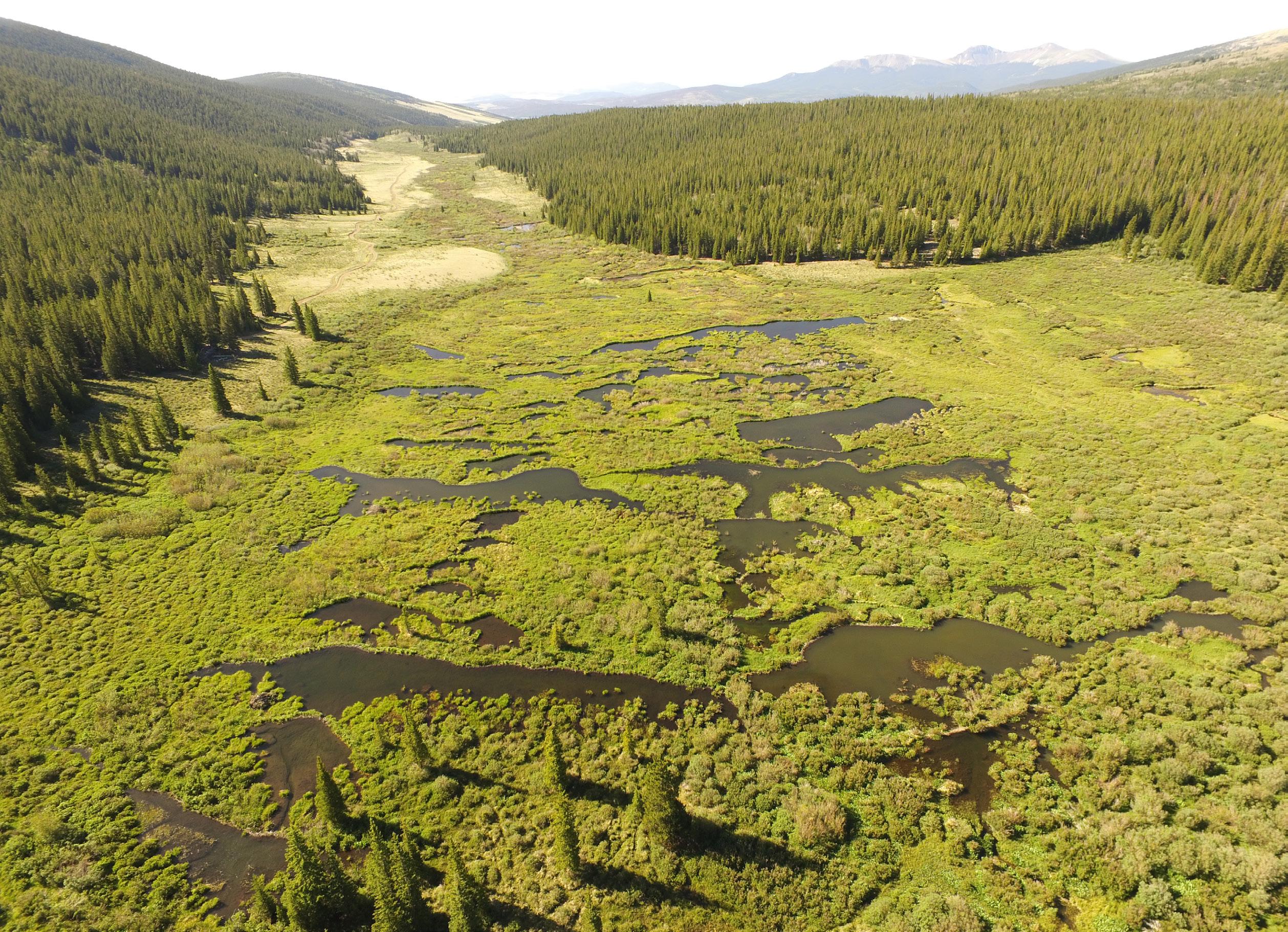 By Kelly Bastone
By Kelly Bastone
Intrepid though they were, the first European explorers and settlers along the West’s various river systems did a lot of complaining. Pioneers groused about downed trees blocking their path and waterlogged ground that made footing treacherous. Mosquitoes, debris jams, underwater snags, and a confusing network of secondary streams thwarted
humans’ attempts at efficient travel.
“It was hard to boat, hard to hike,” explains Ellen Wohl, an author and geosciences professor at Colorado State University who has researched written accounts of early exploration–along with virtually every other aspect of changing stream structure and ecology. A self-professed fast-talker and a preeminent expert on how rivers
interact with the land over time, she rattles off terms such as “spatially heterogeneous” and “morphological influences” with the casual ease of someone ordering a pizza. Yet she also translates fluvial geomorphology into blessedly common language: In their natural state, says Wohl, streams are messy. “They’ve got pools, riffles, constrictions and expansions, logjams, beaver
HEADWATERS SUMMER 2023 • 11
Sheep Park, just south of Fairplay, Colorado, represents a near-pristine, stage-zero headwaters system.
Mark Beardsley
dams, and wetlands that spread across the valley floor.”
Such tangles were particularly thick at headwaters—the source streams feeding into the larger rivers that we know by name, such as the Colorado and South Platte rivers. Beavers typically turned these smaller waterways into a vexing labyrinth of dammed pools and wetlands choked with water-loving willows and trees.
And so, feeling antagonized by the headwaters’ soggy, messy terrain, Colorado’s early European settlers devoted their
energies to tidying up. They extirpated the beavers and demolished their dams; settlers also straightened and diverted the streams to irrigate crops and fill miners’ rocker boxes. Human engineering replaced nature’s infrastructure across most of the state’s headwater systems. Consequently, neat channels surrounded by pliant grasses replaced the jumble of wetlands that once characterized source streams from the Eastern Plains to high-alpine valleys.
Fast forward almost 200 years and Colorado communities are facing new threats.
Catastrophic wildfires, enduring drought, and waterborne pollutants endanger the many cities that developed downstream of headwater systems. Experts now believe that the swampy ecosystems that once tormented early explorers may actually become allies in weathering and adapting to these new threats. Restoring natural infrastructure, such as beaver habitat and the wetlands it creates, could shield communities from damaging floods, purify water of toxins and high sediment loads, and reduce the apocalyptic effects of megafires.

12 • WATER EDUCATION COLORADO
Ellen Wohl, is a geosciences professor and researcher at Colorado State University, author and renowned leader in geomorphology and restoration. Here, she poses for a photograph along Spring Creek, a small stream that flows through Fort Collins and the surrounding urban area and is protected along much of its length by open space and natural areas.
Such benefits become possible when people appreciate the genius of headwaters’ natural state—but only if people can learn to live with their mess.
***
The Big Thompson River headwaters flow through Moraine Park, which doesn’t appear to be degraded—at least not to most observers. They see a simple ribbon of water snaking among grasses that allow for unobstructed views of the surrounding
summits as well as the valley’s resident elk—making this one of the best-loved areas of Rocky Mountain National Park. Even anglers flock here to cast for Big Thompson trout without worrying about tangling their lines in trees or shrubs, both of which are largely absent.
However, this kind of naked channel isn’t natural, explains Mark Beardsley of EcoMetrics, a collective of scientists that analyzes and restores headwaters. The Big Thompson’s ribbon-like stream resulted from previous generations’ attempts to impose order on what was once a jumbled, waterlogged valley. Before, willows and trees slowed the water’s flow and created sanctuaries for juvenile members of many wildlife species. The slower water also would let woody debris like leaf litter, branches and roots settle out of the flow, keeping downstream rivers cleaner.
But in its current state, says Wohl, “Big Thompson in Moraine Park provides less attenuation of water, solutes [such as nitrate], and sediment moving downstream, and less diverse and abundant aquatic and riparian habitat than it provided when the beavers were more active there.” And across Colorado, many headwater streams now look as stripped-down as the Big Thompson. “We have simplified our headwaters into ditches,” says Wohl. “Like a tree that’s had all its branches cut off, but actually, all those branches are really important to the health of the tree.”
Changes began with the fur trade in the early 1800s, when trappers all but eliminated beavers from Colorado. By some estimates, today’s beaver population represents just 10% of historical numbers. Without
those dam-builders, many headwaters lost the ponds and waterlogged uplands that once filled valleys such as Moraine Park. Where wetlands persisted, settlers drained them to establish streamside homesteads and ranches.
Scientists define streams by numerical order: A first-order stream has no tributaries, and a second-order stream is created at the confluence of two first-order drainages. Headwater streams are typically first- and second-order streams. They can be found at various elevations, from mountain valleys to the plains, and their characteristic plants vary by ecosystem. Regardless of where they’re located, headwaters often take on tangled shapes that slow the water’s progress and distribute it across meandering oxbows and liquid fingers that look more like wet webs than streamlined ribbons. Though some Colorado headwaters stop flowing during dry seasons, historically they’re moist, soggy places that keep water on the landscape, like sponges.
And headwater streams are often so small that they could be plowed over or piped underground, explains Wohl. Many were diverted to run mines and ranches. Others served as flumes conveying felled timber, and, says Wohl, as those logs rode snowmelt rushing downstream “it was like taking a scouring brush to the channel.”
Over time, as headwater streams lost their “branches” and became a single trunk of water, they began to act like irrigation ditches that accelerate water, and everything in it, to locations downstream. With climate change intensifying both

HEADWATERS SUMMER 2023 • 13
Matt Staver
We have simplified our headwaters into ditches … Like a tree that’s had all its branches cut off, but actually, all those branches are really important to the health of the tree.”
—Ellen Wohl, Colorado State University
storms and droughts, the canal-like efficiency of modified headwaters is proving to be a detriment for communities across Colorado. “Floods get bigger, with a higher peak flow for a shorter time,” Wohl says. Researchers are only now beginning to measure the flood-intensifying impact of channelized headwaters and every site is different, but according to unpublished modeling studies conducted by Nicholas Christenden, a PhD student at CSU’s Department of Civil and Environmental Engineering, one Front Range site demonstrated that restored beaver structures and associated vegetation might attenuate peak flow by 26%.
Faster, stronger floodwaters pose many long-term threats to stream and community health. They threaten bridges and riverside roads, and pollutants—including everything from sediment to agricultural chemicals—get funneled into municipal water sources.

Biodiversity also suffers from this channelization, because without complex wetlands and floodplains, streams support a less diverse population of insects, fish, amphibians, plants, birds and even bacteria.
Yet Colorado has managed to preserve a limited number (about 20% of the state’s total headwaters mileage, estimates Wohl) of “stage-zero” headwater streams that still function as nature designed. On this scale developed a decade ago and commonly used by stream health
practitioners, stage zero refers to these un-altered systems. As streams degrade they can go from stage zero up to stage four before they start to recover. The scale maxes out with stage-eight streams, which have recovered to near pre-disturbance levels. Stage-zero systems demonstrate remarkable resiliency during extreme weather events, and they’ve persuaded some experts that we need to up our investment in preserving and restoring headwaters, not as we made them, but as they were.
Should you hike up to the uppermost reaches of Cochetopa Creek, within La Garita Wilderness in the San Juan Mountains, you will find a waterlogged, willow-choked valley that Wohl adores. “Oh it’s beautiful,” she croons of this stage-zero gem. With its beaver ponds and meandering secondary channels where juvenile amphibians and fish can take shelter and grow, the Cochetopa Creek headwaters is a de facto sponge that slows and retains water passing through. Floods are dispersed across its many inlets, which trap pollutants and suspend sediment and return clear water to the flow downstream, just as a water treatment plant might do, but without the multi-million-dollar price tag. Thus the chain-of-ponds system also reduces the impact of high-energy surges. That water-purifying capability also traps atmospherically deposited nitrates, phosphates and other
chemicals, which would otherwise concentrate in downstream water bodies where they trigger toxic algae blooms, says Wohl, who published her findings in a 2018 paper for Biochemistry.
“Certainly we see significant benefits downstream,” explains Dan Brauch, a Gunnison-area fisheries biologist with Colorado Parks and Wildlife. Cochetopa’s stage-zero beaver complexes store water that’s slowly released during late summer’s hot, dry periods, which improves water quality and quantity for downstream trout, Brauch says. “That water retention is also important to this area’s agricultural properties, because it means that more water is likely to reach
14 • WATER EDUCATION COLORADO
***
The water that comes out doesn’t have a lot of sediment, so it costs us a little less money to put it through the treatment process, and we pass that savings along to residents of Glenwood Springs.”
—David Boyd, White River National Forest
those irrigators for a longer portion of the season,” he continues. Of course not all stream systems react to beaver activity in the same way. A 2015 study looking at the impacts of beaver dams on streamflow and temperature in Utah found that beavers don’t have consistent results on streamflow. During the study period, beaver development caused more variability in stream systems but, the report says, continued study is needed to better predict and understand beavers’ impacts.
The complex of wetlands found in intact headwater systems, such as at Cochetopa Creek, also can serve as a fire break and refuge for the area’s animals during wildfire.

“Every living thing that can get there will,” attests Beardsley. After widespread fires, waterlogged headwater systems remain as a “big green patch,” he continues, from which repopulation efforts take hold in the surrounding burn.
These wetlands even sequester carbon in the floodplain to counterbalance the factors fueling climate change. Wohl’s study of North St. Vrain Creek concluded that while its broad, sponge-like floodplains represent just 25% of the total channel length within the river network, they store 75% of its organic carbon. “Headwaters that remain in their original condition provide a lot of ecosystem services,” Wohl says.
Residents of Glenwood Springs, for example, enjoy lower water costs because several of their headwater systems retain many of their natural processes. “Bison Lake Basin, No Name Creek and Grizzly Creek watersheds are [considered] stageone watersheds exhibiting high geomorphic, hydrologic, and biotic integrity,” says David Boyd, public affairs officer for the White River National Forest, where these headwaters are located. That’s advantageous to the city’s water treatment, explains Matt Langhorst, Glenwood Springs’ public works director. “The water that comes out doesn’t have a lot of sediment, so it costs us a little less money to put it
HEADWATERS SUMMER 2023 • 15
Along Stroh Gulch, a headwater stream in Parker that feeds into Cherry Creek, developers are building the new 1,200-acre Tanterra development with the stream top of mind. The Mile High Flood District and partners have developed a plan that Tanterra’s developers are implementing to revive the stream’s health while allowing development to proceed.
Matt Staver
through the treatment process, and we pass that savings along to residents of Glenwood Springs,” he continues.
What’s more, these headwater wetlands also support a boggling diversity of flora and fauna, says Sarah Marshall, a wetland ecologist with CSU’s Colorado Natural Heritage Program. “The most intact systems just have more species,” she explains. “Birds, mammals, bugs, bats—all of it,” she continues. “Between the sights and also the sounds, it’s a very rich sensory experience to be in a diverse wetland.”
Headwaters’ power is their complexity, says Marshall. “When you take water out of that system,” as has happened at the Big Thompson and so many Colorado headwater streams, “You take away that complexity piece.” It’s like trying to support a reef ecosystem without the coral. Headwater wetlands, like coral reefs, “Provide a structure or a home for a lot of living species, and is itself a living thing, with fungi and bacteria that live in the soil,” Marshall explains. Trout, for example, depend on the deep pools that beavers create to survive the cold Colorado winters, because only those pockets stay warm enough to keep fish alive, whereas most headwater streams are so shallow that they freeze solid.
Yet defining what “healthy” means when describing headwater streams remains challenging, says Marshall. Health isn’t based on easily definable traits and each system is unique. Still, says Wohl, there are certain markers that generally point to “healthy” headwater systems. “Natural systems are not static, so there should be a range of variability,” she continues. Water flows will vary greatly between peaks and lows; water temperature will differ by location; species’ numbers may also fluctuate. Healthy headwaters, says Wohl, “have the ability to sustain their natural communities.” Thus native migratory birds and wild trout should be able to live, season to season, without replenishment or support from human agencies.
Beardsley, meanwhile, defines a healthy headwater system as one that’s preserved its natural processes. “In human health, we’d say that the person can still perform their vital functions,” he explains. Yes, scientists can measure water quality and use that to indicate something about
purity, but “health is broader than that,” Beardsley explains. “It’s about physical and biological integrity, where plants, animals and abiotic parts all depend on one another.” In other words, he concludes, health is something that’s challenging to define or measure, but “defining and measuring it is something we can and must do to restore healthy watersheds.”
For all their planetary and human benefits, healthy headwaters come with tradeoffs that people sometimes find hard to accept. Hikers don’t like soaking their boots amidst flooded willows that stymy progress. In their natural state, headwaters are jumbled, cluttered places that frustrate our preference for efficiency.
But the biggest concern comes from downstream water users, including some water providers, municipalities, agricultural producers and others who raise concerns about the
potential implications of holding water on the floodplain. These water rights holders worry that water retained upstream in headwaters areas—whether in wetlands or behind beaver dams—might alter or limit the amount of flows or timing of runoff, impacting the water that they legally have a right to use.
But, says Marshall, “If you want to catch fish and you want clean water to drink, you really need the mess upstream.”
When land and water managers or property owners seek to rehabilitate headwater streams that have suffered decades of replumbing and degradation, they can follow a surprising number of clues that indicate how the waterway once functioned.
 Matt Staver
Matt Staver
16 • WATER EDUCATION COLORADO
***
At the Tanterra development site in Parker, Colorado, a diverse array of partners have been collaborating to ensure that as the new community is built, the stream is restored. Partners include the Mile High Flood District, Muller Engineering, HEI Civil, Naranjo Civil Constructors, Westwood Professional Services, E5X Management and Parker.
Some glimpses remain in the written records that settlers left. “There are general land office descriptions, when people surveyed, that document what they saw,” says Marshall. “They are sometimes very descriptive, especially with the acres that were difficult to cross,” she jokes. In their snarled, labyrinthian state, headwaters have never facilitated easy passage for humans’ preferred forms of travel.
Technological imaging can also provide sketches of headwaters’ former shapes, sizes, and historical footprint. “Aerial photography lets us see evidence of where rivers used to be,” notes Marshall. Imprints from former beaver ponds and wetlands often remain on the land and suggest the paths that water used to take through valleys that now evidence a single stream among stark grasses.
LiDAR, which stands for light detec-
tion and ranging, is yet another way that researchers discern evidence of past water patterns. LiDAR has helped water managers assess snowpack depth across various headwaters in Colorado, and the data can also guide practitioners who want to understand what a particular stream looked like before human re-engineering.
“Aerial imagery of the Big Thompson in Moraine Park, as in a lot of mountain parks, shows broad floodplains that used to be a mix of meadows and wet places, with meandering, multi-threaded sliver channels that historically had beavers and large wood,” Marshall explains. But as elk replaced beavers in Moraine Park, the woody vegetation all but disappeared, either because it was browsed by ungulates or didn’t find sufficient water, and the simplified stream dug into the floodplain, losing its connection to the surrounding ecosystem.
Sometimes, Wohl and other researchers look at data, such as streams’ hydrographs, to determine the threshold requirements for sustaining key ecological functions. “Fish spawning, for example, might require a certain minimum flow and distribution,” Wohl explains. Managers can aim for those targets, rather than trying to restore working waterways to their pristine conditions.
Indeed, it’s not always easy—or desirable—to try to recreate the past with today’s streams. After all, they’re living, dynamic systems, not museum artifacts, and they’re healthiest when they have the freedom to change and adapt. “You could pick a point in history to return to,” says Beardsley, “But these ecosystems are always changing and evolving. So there’s no point in trying to create a static system.” The idea is to restore streams’ multi-faceted func-
tionality, so earth, water, rock, chemical and biological elements all work together—and then let the system run itself.
In fact, headwaters’ adaptability is precisely what makes them such valuable assets for human communities looking to boost their resiliency in the face of climate change. “We want systems that can react and adapt to future pressures,” Beardsley continues. When torrential rains fall on mountainsides that have been denuded by wildfire, headwater systems can slow the flooding and filter the water before it arrives at municipal infrastructure—but only if these streams retain some version of their original, natural processes.
That’s why the Mile High Flood District (MHFD) recently helped a landowner in Parker to create a development plan that restored Stroh Gulch, a headwater stream that feeds Cherry Creek. Not that Stroh Gulch was pristine: Located on a cattle ranch, it includes reaches that have lost their native scrub oak and have become channelized. But as the landowner prepared to offer the property to housing developers, the MHFD collaborated on a vision for the project that would revive the headwater stream’s health and meet builders’ economic needs. Three years ago, E5X Management and Muller Engineering Company accepted the project parameters, and this year, construction begins on the 1,200-acre Tanterra development.
Instead of lining Stroh Gulch with concrete and reducing it to nothing more than a ditch, developers are planting grasses, shrubs and trees that restore the stream’s heterogeneity. “We look at them as infrastructure,” explains Barbara
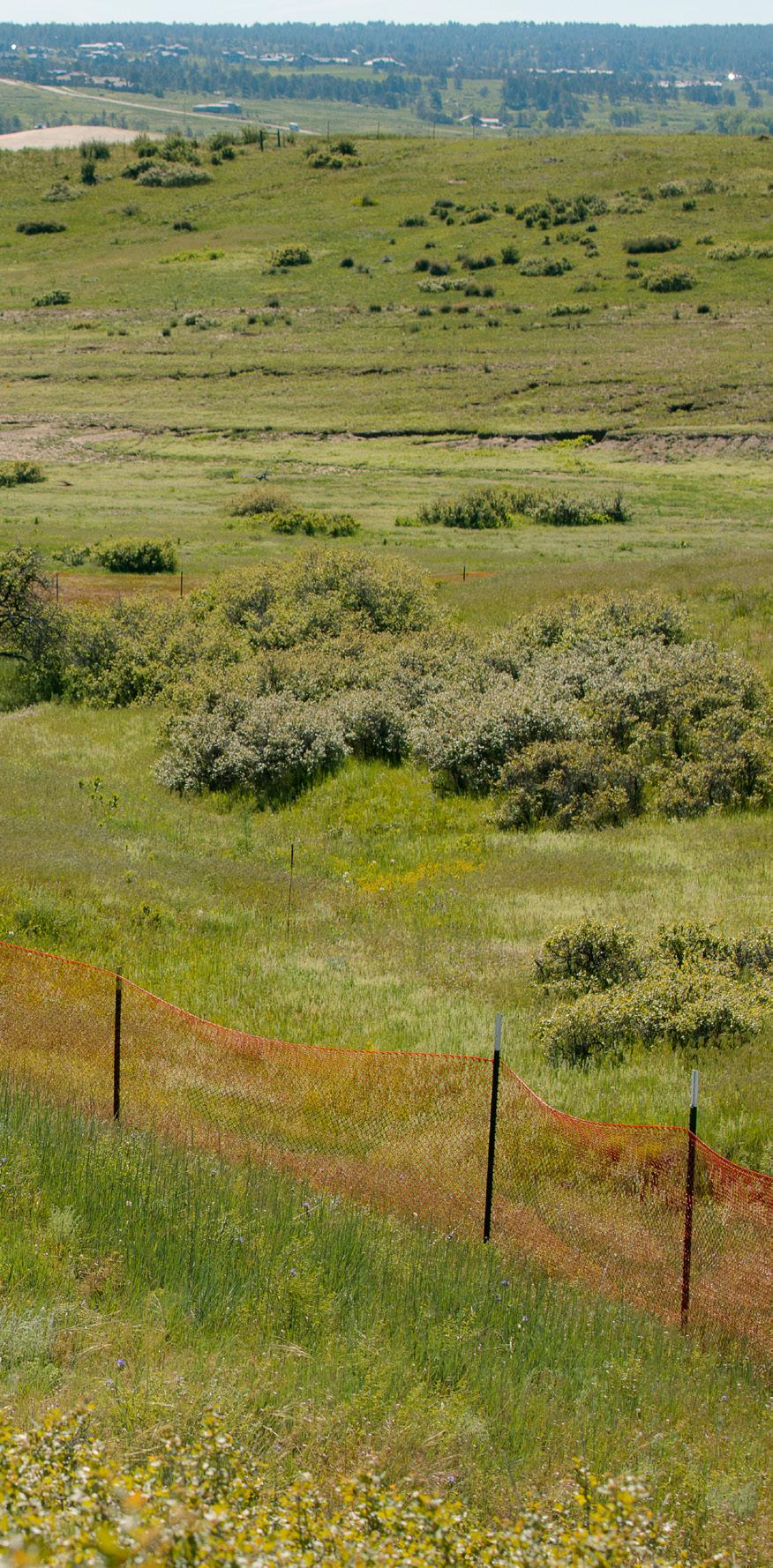
HEADWATERS SUMMER 2023 • 17
The big benefit is that water remains on the landscape. That provides a big resiliency factor in times of drought.”
—Mark Beardsley, EcoMetrics
Healthy mountain meadows and wetlands are characteristic of healthy headwater systems and provide a variety of ecosystem services, or benefits that humans, wildlife, rivers and surrounding ecosystems rely on.

The complex of wetlands and connected floodplains found in intact headwater systems can slow runoff and attenuate flood flows, creating better downstream conditions, trapping sediment to improve downstream water quality, and allowing groundwater recharge. These systems can also serve as a fire break and refuge during wildfire, can sequester carbon in the floodplain, and provide essential habitat for wildlife.
Chongtua, MHFD’s development services director. “One benefit to homeowners is the aesthetic component, that these become places to walk, meditate and play,” she continues. “But the natural system—we refer to it as nature-based solutions—also slows the water down and prevents erosion,” she explains. The water infiltrates the ground closer to its source, so it doesn’t all dump into the active channel. According to simulations conducted by Muller Engineering, the interplay of rocks, shrubs, and trees “really beat down the peak and the frequency of runoff,” says Chongtua.
“The Mile High Flood District is dedi-
cated to protecting people, property, and our environment, and we used to do that with a lot of concrete and rock, to contain [flooding],” Chongtua continues. “But now we’re realizing that we can achieve that protection by working with nature, by working with its living systems, which are a lot more cost-effective and get stronger over time.” Tanterra is just the beginning. Says Chongtua, “This gives us a pilot project that we can scale up.”
Improving the health of Stroh Gulch makes a positive difference, even though the stream isn’t likely to achieve stage zero status. Because, experts agree, headwaters
health isn’t an all-or-nothing game: Degrees matter. The rehabilitation efforts that are most likely to succeed also work by degrees, so that the best candidates for restoration typically retain some of their defining characteristics, says Beardsley. For example, it’s hard to relocate beavers to a zone where they have no food, habitat, or building materials.
It’s difficult to relocate beavers, period, says Beardsley. They’re natural forces that humans can’t readily control. So at Trail Creek, located within the Taylor River headwaters between Gunnison and Crested Butte, efforts merely invited beavers onto the mile-long segment. Wanting to improve
18 • WATER EDUCATION COLORADO
However, many river stretches in Colorado have been impacted by human use. In her book “Virtual Rivers,” Ellen Wohl describes how rivers and headwater systems have been degraded over time. “As land-use changes have resulted in changes to the water and sediment entering stream channels, these channels may become unsightly, pose a hazard to human life and property because of excessive scouring or sediment filling, or no longer provide some desired function, such as fishing.”

Here we see an unhealthy system with an incised stream channel that is disconnected from its floodplain, resulting in reduced water storage, less groundwater recharge, and degraded water quality. Unlike in a wetland system, runoff and flood water flow quickly out of a degraded meadow because they cannot spread out and seep in. Increased flows cause further erosion, cutting deeper and wider channels that are less meandering and sending more sediment downstream.
water quality above Taylor Park Reservoir, local land managers worked with funding partners that included the National Forest Foundation and the Coca-Cola Corporation to restore water-holding wetlands. Beginning in 2021, volunteers sunk wooden posts into the stream banks and wove willows between them to create artificial beaver dams that, they hoped, would attract beavers from the surrounding forests.
It worked: By the following summer, beavers had returned to the valley after a 20-year absence and had constructed a dam and lodge that had begun to saturate the once-parched riparian zone. Retained water
nourished the 200-plus willows that teams had planted, and the revived interaction between plants, water and wildlife promises to reverse the encroachment of sagebrush that had replaced riparian plants throughout the corridor.
“The big benefit is that water remains on the landscape,” says Beardsley. “That provides a big resiliency factor in times of drought.”
Coloradans have different needs and face a fresh set of threats that didn’t bear on those European settlers 200 years ago. “We’ve traded away a lot of those functions and benefits [of headwaters] by some of our past land uses,” says Beardsley. “But
we can trade back, which is exciting.” Trail Creek and related projects indicate that headwater streams can indeed heal, when humans set them up to self-adapt.
“We don’t know how they should respond to a lesser snowpack or drier conditions or wildfire,” admits Beardsley. But he trusts nature to figure it out. “We have to give [headwater systems] what they need in order for them to give back to us.” H
A freelance writer living in Steamboat Springs, Kelly Bastone covers water, conservation and the outdoors for publications including Outside, AFAR, 5280, Backpacker, Field & Stream, and others.
HEADWATERS SUMMER 2023 • 19
Graphics by Restoration Design Group, courtesy of American Rivers
Busy as a Beaver
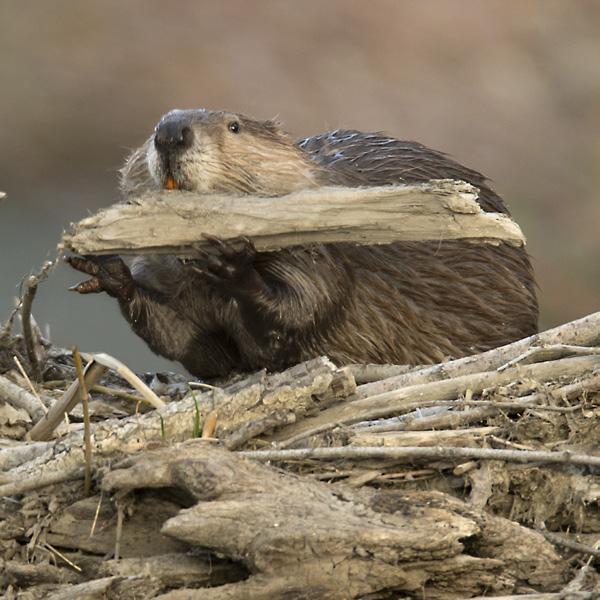
Restoration practitioners mimic beaver to revive Colorado streams
When David Cooper started a research project in Rocky Mountain National Park’s Kawuneeche Valley in northern Colorado in 1996, he chose to eat his lunch at the top of a sunny, 60-foot hill with an uninterrupted view of the Colorado River headwaters below.
Over the course of two decades, Cooper, a senior research scientist emeritus of wetland and riparian ecology at Colorado State University, returned to the hill with his camera to create a visual timeline of the ecological collapse occurring before his eyes.
Cooper’s research team found that the 86-year-old Grand Ditch—a 15-mile water diversion that siphons 20,000 acre-feet of water per year from the Colorado River and transports it to the arid Eastern Plains—had dried out the valley floor, making it difficult for riparian trees and shrubs to grow. Swelling elk and moose populations were overgrazing the remaining vegetation, leaving an already dwindling beaver population with few building materials for their dams. The area’s beaver population was critical to keeping the ecosystem healthy. Without beavers’ careful stewardship, their ponds drained, decreasing the amount of surface water in the area by 95% and dramatically altering the hydrology of the valley, according to Cooper.
BY MOE CLARK
20 • WATER EDUCATION COLORADO
iStock
 Carly Bonwell, courtesy Mountain Studies Institute
Carly Bonwell, courtesy Mountain Studies Institute
It’s a reality that plays out across Colorado and the West. Riparian areas—the lands along the edges of rivers and streams—and wetlands, have been degrading for decades due to mining pollution; overgrazing; flow alterations from dams, diversions and roads; and historical and present-day farming and timber management practices. Approximately 61% of smaller streams and 97% of major rivers in Colorado have experienced floodplain alterations, rendering them partially or wholly nonfunctional, according to a 2017 analysis for the Center for American Progress.
Cooper’s decades-long research helped inform the creation of the Kawuneeche Valley Ecosystem Restoration Collaborative, which is working to restore four riparian areas within the valley by protecting vegetation and mimicking beaver activity in hopes of luring nature’s
master river engineers back to their historical homes. The project, which is primarily using low-tech, process-based restoration (LTPBR) methods, is one of dozens of LTPBR projects occurring across the state—bolstered by a recent influx of state and federal funding.
Process-based restoration (PBR) targets the root causes of ecosystem change, with restoration work tailored to restore a river’s natural processes. Those processes can occur watershed-wide or on a single reach and can include streamflow, flood storage, sediment transport and storage, biological processes, and more. LTPBR is a subset of PBR. While every site is different, LTPBR is generally lower in cost compared to other restoration approaches, and focuses on smaller streams using temporary and often natural structures—such as hand-built wood structures and sod plugs—to slow the water’s flow and allow it to spill out of the narrowed channel and reconnect to its original floodplain.
Research shows that connected floodplains and healthy riparian areas provide ample ecosystem services such as capturing sediment as it heads downstream; filtering out pollutants; storing more water
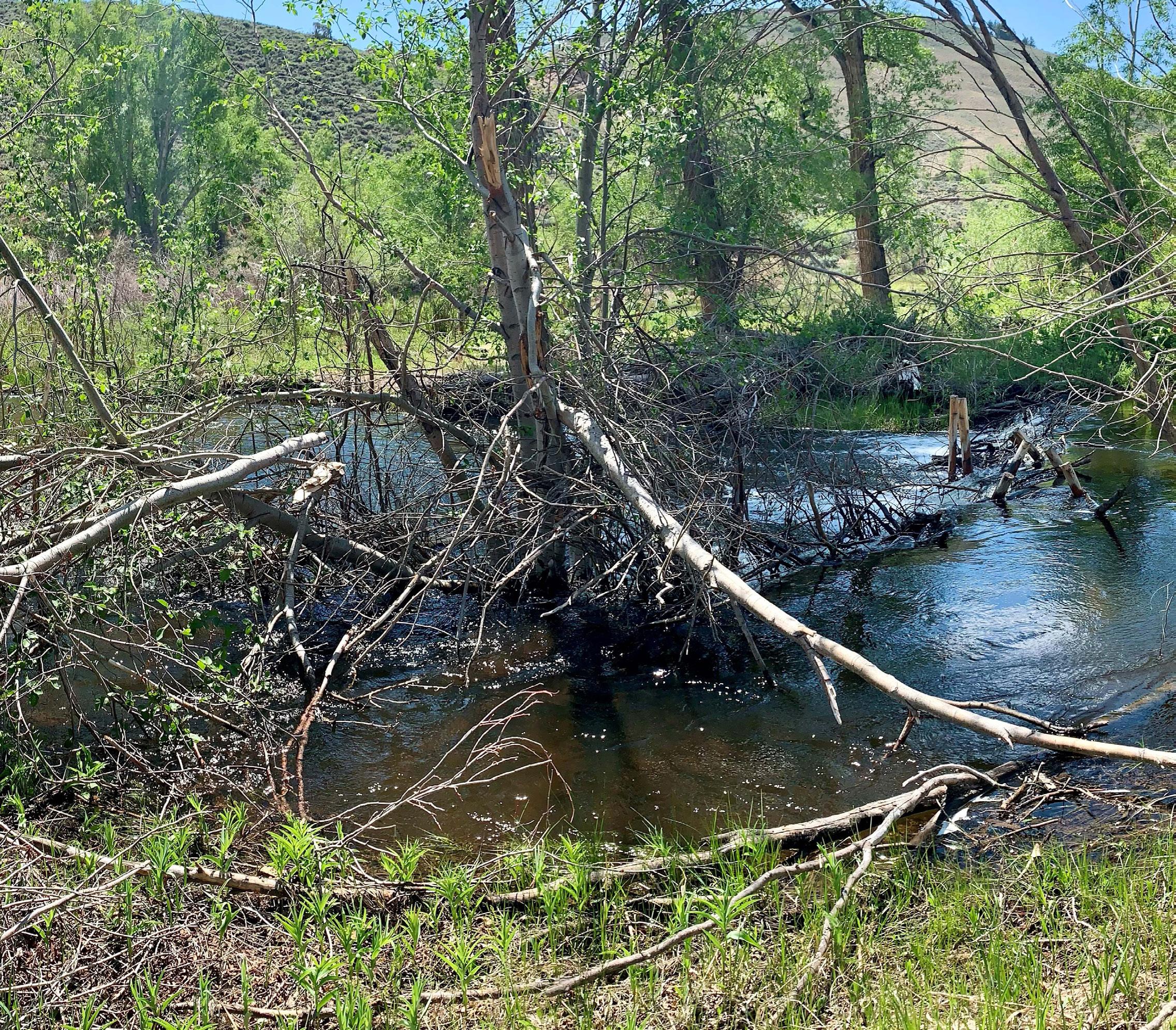
22 • WATER EDUCATION COLORADO
Previous Page: The Mountain Studies Institute along with the Mancos Conservation District, private landowners, Mesa Verde National Park, the Ute Mountain Ute Tribe, researchers, and restoration practitioners install beaverinspired structures to add complexity to the Mancos River.
Beavers are taking over a beaver mimicry structure that was installed near Gunnison, Colorado.
Jackie Corday
on the landscape to increase vegetative growth and biodiversity; and moderating soil moisture, streamflows and temperatures throughout the year. All of this combines to make the watershed more resilient to floods, wildfire and drought.
But research surrounding LTPBR is fairly limited, especially as it relates to how projects might impact downstream water availability and the timing of flows.
Because of this, in part, the process for getting restoration projects approved in Colorado has been somewhat opaque and challenging for practitioners to navigate, prompting state lawmakers to draft a bill this session that sought to clarify the process in order to scale-up efforts across the state. But the final bill was watered down through various amendments brought by industry groups who were concerned with how the projects might impact their priority water rights.
Still, scientists and restoration experts are pushing forward with projects, given the scope of riparian degradation and the strain climate change and population growth continues to have on water resources and the ecosystems that support them.
“We had the century of exploitation where we acted as if our natural resources were unlimited,” says Buffy Lenth, a watershed restoration specialist with Central Colorado Conservancy, an environmental nonprofit based in Salida. “Then, we had this century of preservation where we were like, ‘Oh my gosh, this isn't limitless.’”
“The next century really has to be the century of restoration, where we take better care of the lands.”
RACING TO TURN “BACK THE CLOCK”
Jackie Corday, a land and water conservation attorney based in Montrose, became an enthusiastic proponent of LTPBR methods in 2018, after touring a private ranch in South Park, Colorado, where river restoration scientists successfully restored reaches of a stream that feeds into the South Platte River. The result was more water on the landscape, recovering vegetation, and a river that had repopulated with trout.
“I could see the difference. It just made sense,” Corday says.
At the time, Corday was the water resource manager for Colorado Parks and Wildlife and was asked by Brian Sullivan, the agency’s wetlands program coordinator, to research the benefits—and potential legal barriers—for scaling up those types of restoration projects.
Through her research, which culminated in the 2022 report for American Rivers, “Restoring Western Headwater Streams with LowTech Process-Based Methods: A Review of the Science and Case Study Results, Challenges, and Opportunities,” Corday found dozens of promising LTPBR projects in California and across the western U.S. that successfully “turned back the clock” on the damage done to various riparian areas, streams and wetlands in a more cost effective way.
“You can do it the fast way and come in with a big excavator and try to reset the elevation to what it would have been,” Corday says. “But that's very expensive. It's like $600,000 to $1 million a mile, and there are thousands of miles. It's not even a possible approach [on its own].”
“Also, the science was showing that [a high-tech approach] wasn't necessarily always bringing back the [ecosystem] that you were hoping for,” she adds.
“What these researchers were showing was that, well, there's actually a better way to do this. You mimic beaver.”
Beaver dams have been shown to retain sediment and nutrients, as well as heavy metals, which can improve water quality. A study of 13 beaver ponds in England found that over a four-year period, the ponds trapped a total of 101.5 tons of sediment. And a 2020 study of large western U.S. wildfires published in the Ecological Society of America Journal Ecological Applications found that riparian vegetation around beaver complexes had a three times greater rate of survival than around stream segments without beavers.
Researchers and restoration practitioners in Colorado are building beaver dam analogs and focusing on other LTPBR techniques using natural materials—this is often cheaper and faster to implement than high-tech approaches, at just $50,000 to $100,000 per mile. An example of an LTPBR method would be to install posts vertically into a creek bed to catch wood and debris floating downstream, mimicking natural log jams. This can jumpstart a beaver's home, which naturally slows the flow of water to allow it to pool and rehydrate the soil.
While LTPBR is seemingly growing in popularity, it’s not always the right tool. Sometimes, higher-tech engineering is needed, such

HEADWATERS SUMMER 2023 • 23
as after major flooding events, below dams that alter flows, or when a river’s natural processes have been strained to the breaking point, rendering them unable to self heal, according to a design manual created by Joe Wheaton, an assistant professor of fluvial geomorphology at Utah State Unninversity.
The Beaver Restoration Assessment Tool was designed by Wheaton and his colleagues to help land and water managers identify the historical capacity of streams to support beavers and locate where they might feasibly be able to return. Since 2021, the Colorado Natural Heritage Program at Colorado State University has hosted a state-adapted version of the beaver assessment tool for the perennial stream network in Colorado.
LTPBR also may not be appropriate near housing developments or busy roads, where there is the potential for flooding and infrastructure damage, according to Corday.
“So we have to look farther up the watershed in the public lands and the private lands, the big ranches where there is space for the river to be natural again and to reconnect with its floodplain,” Corday says.

Funding for this type of work used to be hard to come by. But as of late, money at all levels of government has been flowing.
Programs focused on improving watershed health have the potential to access a substantial increase in federal funding from 2021-2026 through the Infrastructure Investment and Jobs Act and the Inflation Reduction Act. And in 2021, Colorado Parks and Wildlife classified beavers as a priority species, which gave beaver-related wetland and riparian restoration projects a higher priority for grant funding from the state. Even locally, some conservation districts have passed ballot initiatives to generate funds that can be applied toward improving water resources on natural landscapes, such as the Colorado River Water Conservation District’s Community Funding Partnership.
“It's a once-in-a-lifetime slug of money,” Lenth says. “So I think that barrier is kind of in the midst of dissolving right now.”
But there is still a lack of funding for project planning, permitting and monitoring, especially in rural communities, she adds. And the permitting process for restoration work can be long—and expensive.
Once more monitoring data is available, permitting—which takes anywhere from a few months to over a year—will hopefully be expedited, Corday says.
LETTING THE SYSTEM DO THE WORK
Melissa May, executive director of the Mountain Studies Institute in Durango, is working with a research team in southwestern Colorado—alongside members from the Mancos Conservation District, private agricultural landowners, Mesa Verde National Park, and the Ute Mountain Ute Tribe—to utilize LTPBR methods to make the Mancos watershed more resilient to drought and wildfire.
In summer 2022, the team installed beaver-inspired structures to add more complexity to the Mancos River. To their excitement, one of the structures located on a stream along private lands near Mancos attracted the attention of nearby beavers. They had hoped that the beavers would make it their home, but the structure was washed away in this year’s spring runoff.
“So, that was sort of a lesson learned. Maybe the structure would have held during a dry year. [Runoff] was just so strong this year,”
she says. “We are now thinking about how much maintenance these structures will need from year to year.”
May’s team is also working with biologists from the Ute Mountain Ute Tribe to remove invasive plant species, such as tamarisk shrubs and Russian olive trees, that slurp up precious water and push out more culturally and biologically important plants such as cottonwoods and willows.
May says the goal is to let the system do the work. “A lot of those [strategies] are focused on slowing down and spreading out the water. So instead of having one giant monsoon storm and the water just flashes right through and doesn't seep into the system, how can you create complexity in the stream channel, where the water slows down and is able to recharge the groundwater a little bit and support these flows?”
While the retiming of flows and the potential for LTPBR projects to affect water rights is a concern for some, those at the Mancos Conservation District who are working with May and nearby landowners say that this hasn’t been an issue.
“This idea that we’re not stopping water or damming the river, we're not stopping the flow, we’re just slowing down water and recharging the floodplain, that was important especially for agricultural
24 • WATER EDUCATION COLORADO
Courtesy Northern
Water
Members of the Kawuneeche Valley Ecosystem Restoration Collaborative walk along an abandoned irrigation ditch during a tour of the valley in July 2022.
[water] users,” says Sensa Wolcott, watershed coordinator for the Mancos Conservation District.
The conservation district team has been particularly cognizant of water rights, irrigation infrastructure, and the potential for landowner concerns. But the fact that they’re implementing smaller beaver mimicry projects, not massive dams, has encouraged landowners. “That has been helpful to make people more willing to try [LTPBR,]” Wolcott says.
Back at Rocky Mountain National Park, the Kawuneeche Valley Ecosystem Restoration Collaborative—which includes the National Park Service, Northern Water, the U.S. Forest Service, the Colorado River District, The Nature Conservancy, Grand County, and the Town of Grand Lake—is taking a similar approach this summer by installing beaver-like structures within Beaver Creek to slow streamflows, catch sediment, and promote vegetative growth farther from the banks.
“We're really looking to improve the habitat, kind of the Field of Dreams approach, where if we improve the habitat in the area, then hopefully beavers will come back on their own,” says Kimberly Mihelich, a water protection specialist with Northern Water, a water con-
servancy district that serves eight counties in Northeastern Colorado.
The group—funded by the Rocky Mountain Conservancy, The Nature Conservancy, Northern Water, and the Colorado Water Conservation Board—isn’t looking to re-introduce beavers into the ecosystem since the environment wouldn’t be able to support them given the lack of vegetation available for them to build dams. But beavers have started to show interest.
In summer 2021, the group stumbled upon something they hadn’t seen in nearly two decades—an active beaver dam. The beaver home was nestled within a 35-acre, fenced-in restoration area in the valley that had been installed a decade ago to keep moose and elk from overbrowsing the willow trees. The fences have gaps in the bottom so small animals such as beavers can slip through.
“We were like, ‘Oh my gosh, these fences work!’” Mihelich says. “There was so, so much excitement.”
“[The beaver dam] did get washed away in some of the spring runoff,” she quickly adds. “But it was really exciting to show that if the habitat is there, beavers in the area might make it home.” This isn’t unusual, bever dams are often damaged during large floods, but the beaver are able to rebuild if the environment can support them.
This summer, the team will install more fence enclosures to keep moose and elk from overgrazing the restoration areas and will continue using herbicides to kill off invasive plants.
Mihelich says Northern Water is involved in restoring the riparian areas because it’s a way to improve drinking water quality. The Colorado River, which winds through the Kawuneeche Valley, is part of a storage system that includes Grand Lake, Shadow Mountain Reservoir and Granby Reservoir on the Western Slope. The system has struggled with poor water quality due to increases in fine sediment loading, debris and nutrients, all of which impair water quality and can clog up water infrastructure. The system has also been impacted by recent wildfires, which are increasing in frequency and intensity due to climate change.
But restoring the riparian zones and changing the hydrology of the valley will take time, says Koren Nydick, the resource stewardship manager for Rocky Mountain National Park, especially since the damage has spanned decades.

And efforts to replace natural processes aren’t always as effective as the real thing, she adds. “We aren’t beavers. We can’t do it all,” she says. “The hope is that they come in and do it better than we could ever do it.”
ENGAGING AGRICULTURAL COMMUNITIES
Lenth, the watershed restoration specialist with Central Colorado Conservancy, has been working to engage more ranchers in river restoration efforts given that agricultural producers are the largest water users in the state. Not everyone is always on board. Beavers have historically had the reputation of being a nuisance since they can cause unintended flooding of roads and plug up water infrastructure. She says it’s an easier sell for ranchers when the projects occur on summer pastures and away from any major developments.
Lenth sees riparian restoration as a win-win: it helps make the land, and riparian areas throughout, more resilient to climate change—which can boost a rancher’s bottom line. More water held
HEADWATERS SUMMER 2023 • 25
on the land means more vegetation for grazing, she says.
Lenth has been working on a riparian restoration project in the Badger Creek watershed since 2017, which covers nearly 100 square miles of the southwest portion of South Park and feeds into the Arkansas River. During thunderstorms, the creek is prone to flash flooding, which carries large amounts of sediment downstream and negatively impacts water quality. The area is a patchwork of state, private and federal lands—much of which is used for cattle grazing. Many things, including historical overgrazing, mining and hydrological droughts have caused the creek to incise, narrowing and eroding the stream channel and separating it from the floodplain. This has in turn caused the riparian area to dry out and become barren.
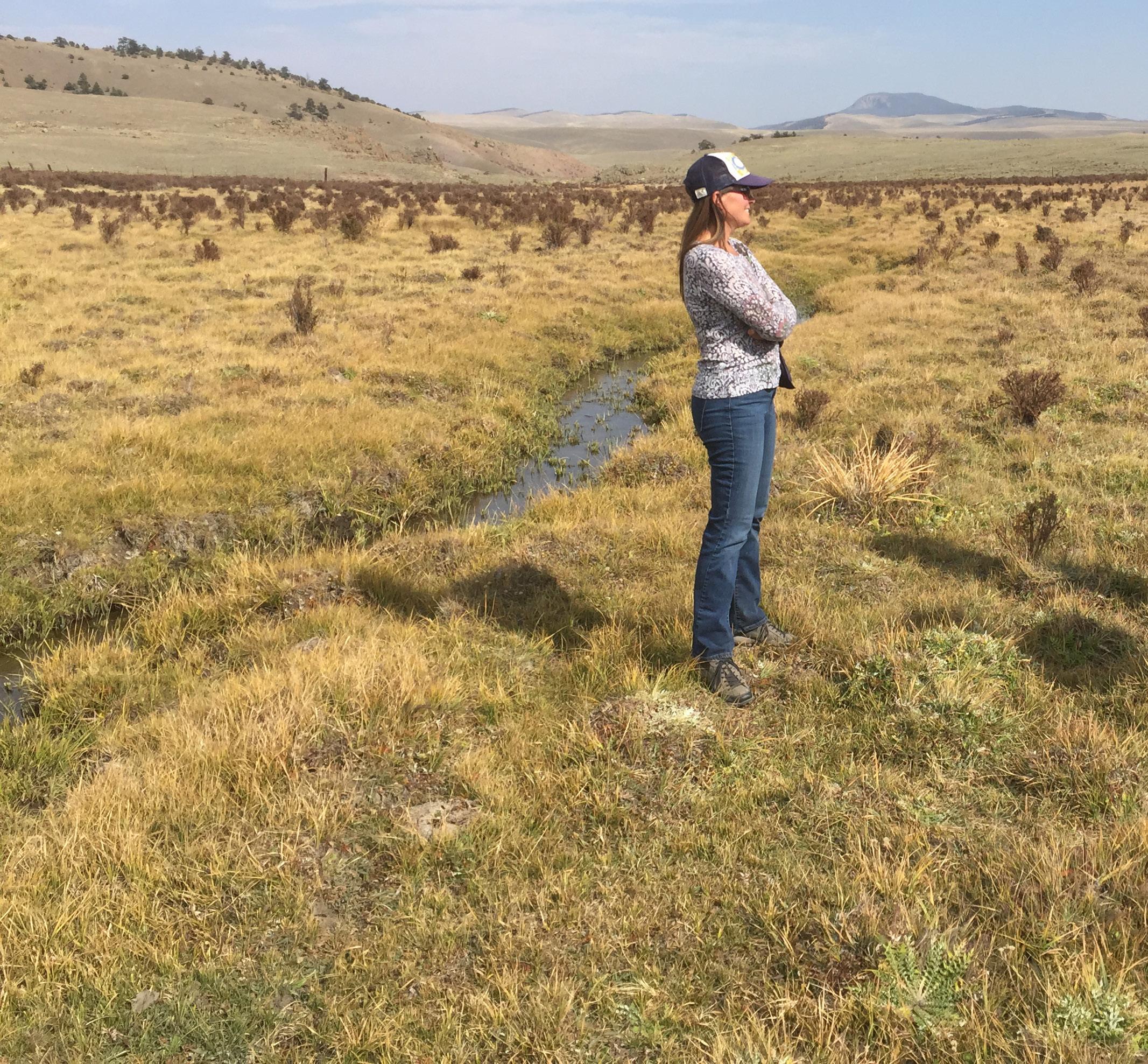
“We're trying to turn that watershed into more of a water catchment, where, when it rains, we have improved plant cover and plant vigor so that we're able to infiltrate more water, capture it and filter it,” says Lenth. “That way the water is slowed down and kept on the
landscape longer to help reconnect those floodplains that have dried out over time.”
To do so, Lenth and a group of collaborators have installed natural “speed bumps”—aka small hunks of sod taken directly from the land, another beaver mimicry treatment—into the deepest parts of the creek. Collaborators include state and local government agencies, conservation districts, EcoMetrics, Trout Unlimited, conservation groups, researchers at Colorado Hertiage Program and Colorado Mesa University, and private landowners. The team has also planted approximately 14,000 willows to try and slow erosion and capture more sediment and water in the process. So far, they’ve “treated” seven miles of the Badger Creek, plus five miles of tributaries, with the speed bumps.
“Wetlands are really nature's system for cleaning, storing, filtering and conserving our freshwater, which is our most scarce resource in the West,” Lenth adds. “If you're going to focus strategically on the
26 • WATER EDUCATION COLORADO
Buffy Lenth with the Central Colorado Conservancy meets with landowners at Badger Creek Ranch near Cañon City, Colorado, where they have been collaborating on a project to restore the watershed and the riparian areas around Badger Creek.
Courtesy EcoMetrics
most ecologically valuable lands and most important issue of our time, I really think it's our freshwater [systems].”
One of the biggest challenges, Lenth says, is managing grazing in riparian areas when there aren't a lot of other options for cows to get water. The team is working to encourage rotational grazing by installing more watering points across the land, as well as fences to allow landowners the ability to control the timing, intensity and duration of grazing along riparian areas.
Throughout summer 2023, researchers will be collecting data on how the project has impacted surface and groundwater levels as well as how much water is being consumed by the new vegetation to be able to better assess the impacts of their efforts. But nearby ranchers say they can already see improvements.
“It’s like night and day,” says Chrissy McFarren, co-owner of the 7,000-acre Badger Creek Ranch, which encompasses part of the watershed. “The thickness and the lushness of it. It looks like wetlands.
Paying For Restoration Work
There are a number of funding opportunities and technical resources available to help implement restoration work, including some available at the local level. Some federal and state funds pools include:
FEDERAL FUNDS:
• WaterSMART Program, U.S. Bureau of Reclamation Supports water conservation, management, and restoration projects through 50/50 cost share funding to various entities across the West. Check out the new WaterSMART Aquatic Ecosystem Restoration Projects grant category.
• Partners for Fish and Wildlife Program, U.S. Fish & Wildlife Service Free technical and financial assistance to landowners, managers, tribes, corporations, schools, and nonprofits interested in improving habitat on their land.

• Wetland Reserve Easements, Watershed and Flood Prevention Operations, and others, Natural Resources Conservation Service The NRCS offers technical and financial assistance through many programs that can be used to protect, restore and enhance watersheds and natural resources.
COLORADO FUNDS:
• Wetlands for Wildlife Program, Colorado Parks & Wildlife Aims to protect wetlands and wetland-dependant wildlife on public and private land. Funding can be used for wetland and riparian creation, restoration and enhancement, and more.
• Watershed Restoration Grants, Colorado Water Plan Grants, Colorado Water Conservation Board (CWCB) Watershed Restoration Grants currently provide funds to support Wildfire Ready Watersheds including plans to manage flooding after fire, engineering projects, and the implementation of projects that protect areas at risk from post wildfire hazards. This can include stream and floodplain restoration and more. The Water Plan Grant program supports watershed health and recreation projects.
• RESTORE Colorado, National Fish and Wildlife Foundation Funds habitat restoration and stewardship projects on public and private conservation lands in Colorado.
• Colorado Healthy Rivers Fund, Colorado Watershed Assembly, Water Quality Control Division (WQCD), and CWCB Supports projects that contribute to cleaner water, healthier habitat, and improved recreation.
• 319 Nonpoint Source Watershed Program, WQCD These funds support the state Water Quality Control Division’s Nonpoint Source Program. Funds can be used for watershed planning or to implement watershed plans in order to reduce diffuse sources of pollution. CONTINUED ON PAGE 30
HEADWATERS SUMMER 2023 • 27
The Process-Based Restoration Umbrella—It isn’t just about beavers
includes active and passive recovery (beaver mimicry is considered active). Even with this diversity of approaches, certain characteristics define what fits within the PBR “umbrella.”
Process-based restoration (PBR) is an important category of restoration work that targets the root causes of ecosystem change and aims to restore a river’s natural processes so the area can begin to self heal. But under the PBR umbrella, there is a spectrum of restoration approaches, which
There’s a lot of talk about the benefits of beavers in stream restoration, but Colorado’s riparian systems are complex—when it comes to restoring stream systems, there isn’t one tool that works in all situations. Rather, there are many tools in the restoration toolbox.
ɠ PBR works with the natural processes that drive ecosystem function and dynamics
ɠ PBR addresses causes of degradation, rather than symptoms of it
ɠ PBR matches the watershed context and human setting of the natural system
LOW-TECH PBR (LTPBR) : Uses simple, temporary, low-unit-cost, typically natural structures, often mimicking beavers, to slow a stream’s flow and allow it to connect with its natural floodplain.
HIGH-TECH PBR (HTPBR): Typically uses more costly treatments, and requires planning and detailed engineering analysis to design for disturbance, with adjustments made over time.
RESTORATION APPROACHES AND TREATMENTS
PASSIVE RECOVERY : Typically requires no restoration design in order to remove sources of disturbance or causes of degradation. This removal allows the river to self heal.
CONSIDERATIONS WHEN SELECTING
When selecting a restoration approach and treatment, water managers and restoration practitioners weigh the following factors. Passive recovery and low-tech active recovery projects fall toward the left and middle of these spectrums, while high-tech active recovery work is on the right side.
PROJECT’S LEVEL OF RISK
Risk factors include stream response potential, infrastructure adjacency, public safety, system scale, etc.
UNCERTAINTY ACCEPTABLE FOR PROJECT
Project tolerance or “appetite” for uncertainty; often but not always inversely proportional to risk
TIME TO DESIRED GOALS ACCEPTABLE FOR PROJECT
Passive and low-tech approaches sometimes, but not always, require more time to see results
LEVEL OF DESIGN ANALYSIS REQUIRED FOR PROJECT
Larger investment in design analysis warranted to address risk, uncertainty and/or time to reach goals
COST INVESTMENT FOR PROJECT
May apply to design, permitting, and/or construction costs; sometimes larger investments decrease time to get results
28 • WATER EDUCATION COLORADO
HIGHER HIGHER LONGER HIGHER SHORTER LOWER LOWER LOWER LOWER HIGHER
DETAILS & APPLICABILITY FOR PBR APPROACHES:
Common level of design analysis required:
ɠ No design required for system recovery
ɠ Design for safe removal of the causative stressor may be required
ɠ Engineering design analysis not required
ɠ LTPBR Manual 2019 provides “guidelines for implementing a subset of low-tech tools (i.e., BDAs and PALs in riverscapes lacking wood and beaver dams”
ɠ Engineering design analysis varies, typically falling between LTPBR and HTPBR
ɠ Analysis required to determine target slopes at minimum
ɠ Full valley reset approach requires significant analysis
ɠ Heavier engineering design analysis required compared to other approaches, but varies greatly across specific projects
Limitations:
ɠ Not helpful when causative stressor (cause of degradation) cannot be removed (e.g., a dam or diversion structure)
ɠ Not intended for non-wadeable, higher order systems where causative stressor is other than loss of wood and beaver dams
ɠ If beaver can’t be expected to move in to the restored area, beaver mimicry structures may be built
ɠ Typically low risk areas with low or no infrastructure adjacency to accommodate floods covering full width of the valley bottom
ɠ Access to full floodplain may currently be impractical due to anthropogenic constraints—Stage Eight might work well instead with restoration to an extent rather than the full floodplain width
ɠ Applies to most systems and causative stressors because customized detailed analysis addresses sitespecific constraints
ɠ Higher cost of analysis and often construction as well
HIGH-TECH (HT)
Channel work–e.g. resizing, shaping, overflow channels (HT)
Wood structures–e.g. large wood structures anchored by ballast or piles (HT)
Full Valley Reset (HT)
Stage Zero
Dam removal with analysis & design for safe removal (HT)
Developed for or applicable to:
ɠ Any system
ɠ Wadeable streams (aka low-order, often headwaters streams)
ɠ Systems where degradation is caused by structural starvation of wood and beaver dams
ɠ Targeted where beavers existed historically
ɠ Typically requires adaptive management
ɠ Most successful in depositional areas with wide valleys and mild slopes to promote deposition
ɠ Often in small, incised streams in wet meadows headwaters, but can be up-scaled to larger rivers
ɠ Promote processes that will nudge the system back toward a Stage Zero condition
ɠ May need sediment supply from upstream to fill incised channels over time
ɠ Works best with adaptive management, but not required
ɠ Detailed analysis allows PBR application on a caseby-case basis to any system
ɠ Works best with adaptive management
Approach:
Passive Recovery (P)
LTPBR & other beaver mimicry (LT), including Beaver Dam Analogs (BDAs),
Post-Assisted Log Structures (PALs), Simulated Beaver Structures (SBS)
Stage Zero Design (LT or HT)
Stage Zero falls between LT & HT in required analysis and construction cost.
Smaller Stage Zero efforts may have LT characteristics, but a larger project such as work covering a full valley, is closer to HT.
HTPBR (HT)
EXAMPLES OF TREATMENTS (NOTING OVERLAP ACROSS RESTORATION APPROACH):
ACTIVE RECOVERY
LOW-TECH (LT)
Leaky beaver dam features (LT)
Wood structures–e.g., BDAs, PALs (LT)
Wood placement without anchoring (LT)
Floodplain reconnection (LT, HT)
PASSIVE RECOVERY (P)
Eliminate grazing (P)
Fence out grazing (P)
Remove invasive weed species (P)
Gravel augmentation (P, LT)
HEADWATERS SUMMER 2023 • 29
There’s more vegetation farther out from the bank. There are more birds and insects.”
McFarren and her husband see it as their mission to leave the land and riparian areas better than they found them. In addition to participating in restoration projects, they are in the process of obtaining conservation easements for their land, and the water that runs through it, to protect it from being developed.
“We're in that place where huge pieces of land are being turned over,” she says, referring to the amount of farmland that has been transformed into developments as farmers age and retire. “There's not a lot of that next generation. So I think for many it is a tool for preserving and keeping land from going to subdivision.”
McFarren is inspired by the amount of collaboration she’s seeing to restore and preserve the Badger Creek Watershed and its surrounding riparian areas.
“I know there's been a lot of collaborations in the past, but I think that's happening more and more and I think that’s the big picture solution to climate change issues and drought,” McFarren says. “We all have to come together and work on this together. Because we're not headed in a good direction.”
“The whole idea of like, well, just leave nature alone, let it do its thing. It's like, well, we were part of the problem,” she says. “We need to be part of the solution.”
LEGISLATION TO PAVE THE WAY FOR MINOR STREAM RESTORATION PROJECTS— BUT NOT LTPBR
In 2019, Corday helped create Colorado’s Healthy Headwaters group, which included conservationists, academics, NGOs, state and federal agencies, and water stakeholders, to come up with policies and strategies to scale up riparian restoration projects throughout the state. The group influenced legislation that was drafted by DWR and later introduced by state lawmakers in April 2023 as SB 23-270. But amendments added left the bill to only include “minor” restoration projects—and removed language related to LTPBR projects.
“Those (LTPBR) projects promote a lot of ecological uplift. But those projects were the least understood and raised the most concerns for water users,” says Kelly Romero-Heaney, the state’s assistant director for water policy with the Colorado Department of Natural Resources. “And so that's why we ended up having to amend coverage for those projects.”
The bill, which was signed into law on June 5, clarifies that minor stream alterations such as bank stabilization or restructuring a channel after it’s been damaged by wildfire or flood are presumed to not impact water rights users.
“The key [in the final bill] is there can only be an incidental amount of flooding or pooling with those structures and they can't exceed the ordinary high water mark, so they can't push water outside of the natural channel,” says Romero-Heaney.
For minor restoration projects defined in the bill, a person or group does not need to go to water court, obtain water rights or get a plan of augmentation, according to Romero-Heaney. Projects established before August 2023 are also “grandfathered in” meaning they are presumed to not impact water rights and can move forward.
Those who sought to amend or defeat the bill included various agricultural groups, cities, water districts, and some environmental groups.
“Their concerns are that their water rights may be injured by a stream restoration project that changes the timing in flow or increases evapotranspiration associated with the growth of trees and shrubs along the river corridor,” says Romero-Heaney, who also sits on Gov. Jared Polis’ policy team as a special advisor on water policy. “What we hear a lot is it might be ‘death by 1,000 cuts.’”
Tyler Garrett, the director of government relations for Rocky Mountain Farmers Union—a group that represents 17,000 farmers and ranchers across Colorado, New Mexico and Wyoming—told state lawmakers that his main concerns with the original bill were related to what recourse a person could seek if their water rights were impacted by a restoration project, and the amount of time they had to file a complaint or lawsuit.
“The geomorphic changes may not even be completed during this two-year window and injury may not be realized,” he said during the bill committee hearing this spring. “We also need to ensure the water right holders have time to collect the proper data and build a proper suit when they are injured.”
Romero-Heaney says it will take time for the Department of Natural Resources to interpret the new law in order to provide guidance to existing project managers and other entities interested in restoration work.
“We need to give time for the water community to have conversations around this,” she says. “So that it's not just DNR owning this policy.”
Over the summer, Corday says the Colorado Healthy Headwaters group will continue having conversations on how to streamline the process for restoration projects in the hopes of potentially introducing another bill next legislative session to expand the existing law’s scope.
Romero-Heaney is excited to participate and help coordinate field trips for members of the water community to see process-based projects in action.
“For a lot of folks, these were novel concepts and certainly, you know, they're looking to protect their water rights or they're concerned about any kind of in-stream activity that could injure them,” she says.
She hopes the conversations help bridge the divide between the ecological community and the water attorneys that work on protecting water rights portfolios.
“We need projects that are reconnecting channels and floodplains and restoring the riparian corridor. We're hopeful that the water community as a whole is open to having a conversation around that in the future,” Romero-Heaney says.
For Corday, the bill is a step in the right direction.
“It certainly wasn't the big W that we hoped for. It was more of a little win,” she says “It’s an incremental step. And there’s more work to be done.”H
30 • WATER EDUCATION COLORADO
CONTINUED FROM PAGE 27
Moe K. Clark is an independent journalist based in Denver. She covers topics related to the criminal justice system, environmental issues and housing/homelessness.
MEMBER’S CORNER
Our members never stop learning
Water Education Colorado relies on a variety of funding sources to operate our educational programs and produce our award-winning publications and WEco memberships account for nearly 30% of our program revenue. We are truly grateful to our new and returning members for the impact their support provides!
This issue we’re highlighting one of our new members, Perry Buck, who has served as a Weld County Commissioner for the past 2 ½ years. Weld County is Colorado’s leading producer of cattle, grain and sugar beets. Prior to this role, Perry was a Colorado state legislator from 2016-2020.
Perry became aware of Water Education Colorado in her legislative work. When asked what compelled her to become a WEco member, Perry shared, “Although Weld County does not participate in water issues, municipalities do, and there are 31 municipalities in Weld County. While Weld County has very little water rights, water is the most important resource to a county, it is the ‘life blood’ of any community.”

Perry has enjoyed reading articles in Headwaters magazine and added, “No one can afford to stop learning about water.” WEco couldn’t agree more! Perry, thank you for your support!
And thank you to all of our WEco members!
MISSION: IMPACT ENGAGE VOLUNTEER GIVE
Dive in to our diverse programming. Find more information on our website. A few ideas to pique your interest:
1
Save the dates: Sep. 6 for our annual President's Reception and Oct. 3–5 for the 2023 Sustaining Colorado Watersheds conference!
2 Are you an educator or outreach professional? Become an affiliate of the Water Educator Network for trainings, networking and collaborations.
3
Make your voice heard! Visit our social media pages or craft a letter to the Fresh Water News editor to share your thoughts, opinions or experiences.
We rely on our volunteers! Email us at info@wateredco.org to express your interest:
1 Share your expertise and we’ll plug you in—as a blog contributor, a speaker, or a peer reviewer for publications.
2 Join a contact list to provide local support when we bring one of our programs to your area.
3
Help us connect with Colorado's Spanish-speaking communities to provide new educational resources and opportunities tailored to them.
Water Education Colorado is the leading organization for informing and engaging Coloradans on water. Through leadership training, educational resources, and programming, we are working toward a vibrant, sustainable and water-aware Colorado.
718,455
Coloradans represented by the state senators who attended our 2023 Yampa/White/Green Basin Tour.
Your gift advances an engaged Colorado, leading to informed decisions and sustainable solutions. Three ways to give:
1 Make a gift to support WEco's mission and programs by donating online at wateredco.org/donate.
2 Sponsor an upcoming program or event to showcase your organization's support for water education. Visit wateredco.org/ get-involved/sponsorship-opportunities to learn more.
3
WEco now accepts charitable gifts of appreciated stock—you get double the tax benefit! Contact Geoff@wateredco.org.
Not a member yet? Join the WEco community at watereducationcolorado.org.
HEADWATERS SUMMER 2023 • 31
A COMMUNITY OF PEOPLE WHO CARE ABOUT WATER
IN THE
SPOTLIGHT
WATE R EDUCATION COLO R ADO .O R G
Publication of Water Education Colorado's Headwaters magazine is made possible by the generous support of sponsors and advertisers. We would like to extend our appreciation and thanks to these sponsors for contributing financially to this issue.
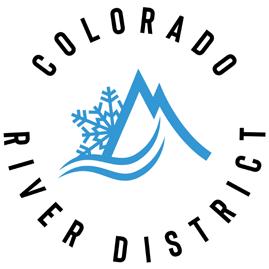

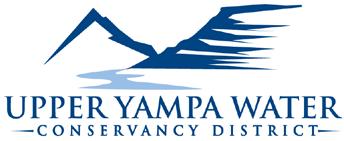



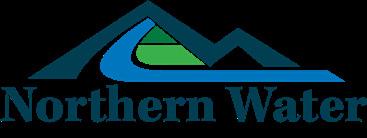

CSU Spur, Hydro/The Shop 4777 National Western Drive Denver, CO 80216 NONPROFIT ORG U.S. POSTAGE PAID DENVER, CO PERMIT NO 178





 By Kelly Bastone
By Kelly Bastone

















 BY JERD SMITH
BY JERD SMITH


 By Kelly Bastone
By Kelly Bastone




 Matt Staver
Matt Staver




 Carly Bonwell, courtesy Mountain Studies Institute
Carly Bonwell, courtesy Mountain Studies Institute














